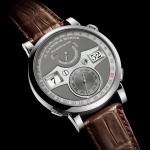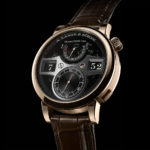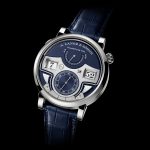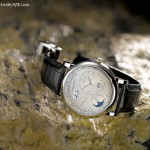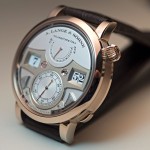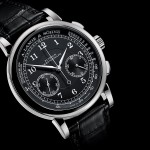Up Close: A. Lange & Söhne Zeitwerk Second-Generation (Refs. 142.025 and 142.031)
Substantially reconstructed, gently redesigned.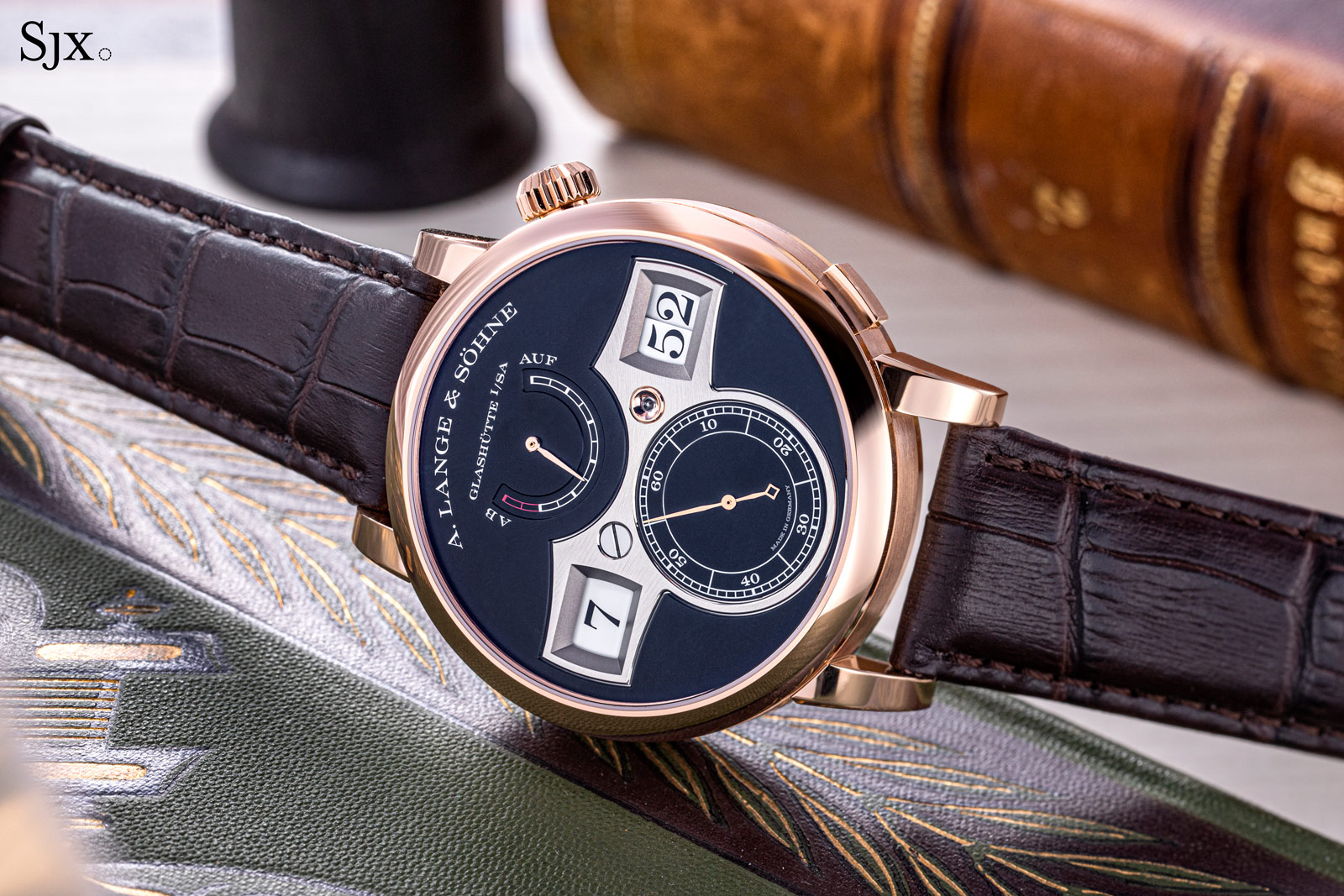
A certainty after the Zeitwerk Date of 2019 and last year’s Zeitwerk Honeygold Lumen, the second-generation A. Lange & Söhne Zeitwerk is finally here. As expected, the new Zeitwerk is a gentle evolution from the original in terms of design, but a substantial step forward in technical terms.
Known as the ref. 142.025 in platinum and ref. 142.031 in pink gold, the new Zeitwerk is powered by the same revamped movement L043 movement found in the Date and Lumen. As a result, it has all of same upgrades, namely a thinner movement that boasts a quickset corrector for the hours as well as a 72-hour power reserve.
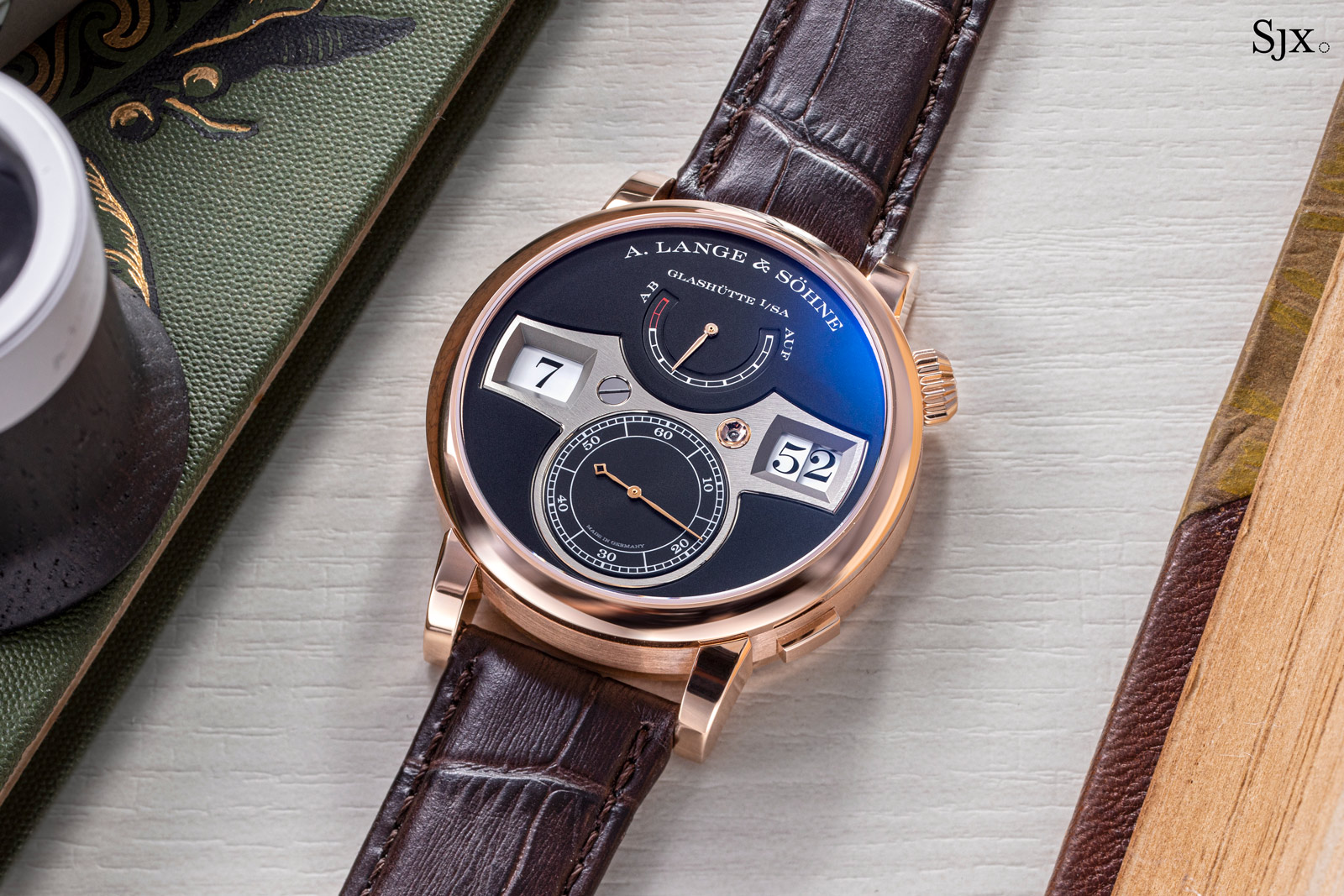
The new Zeitwerk in pink gold
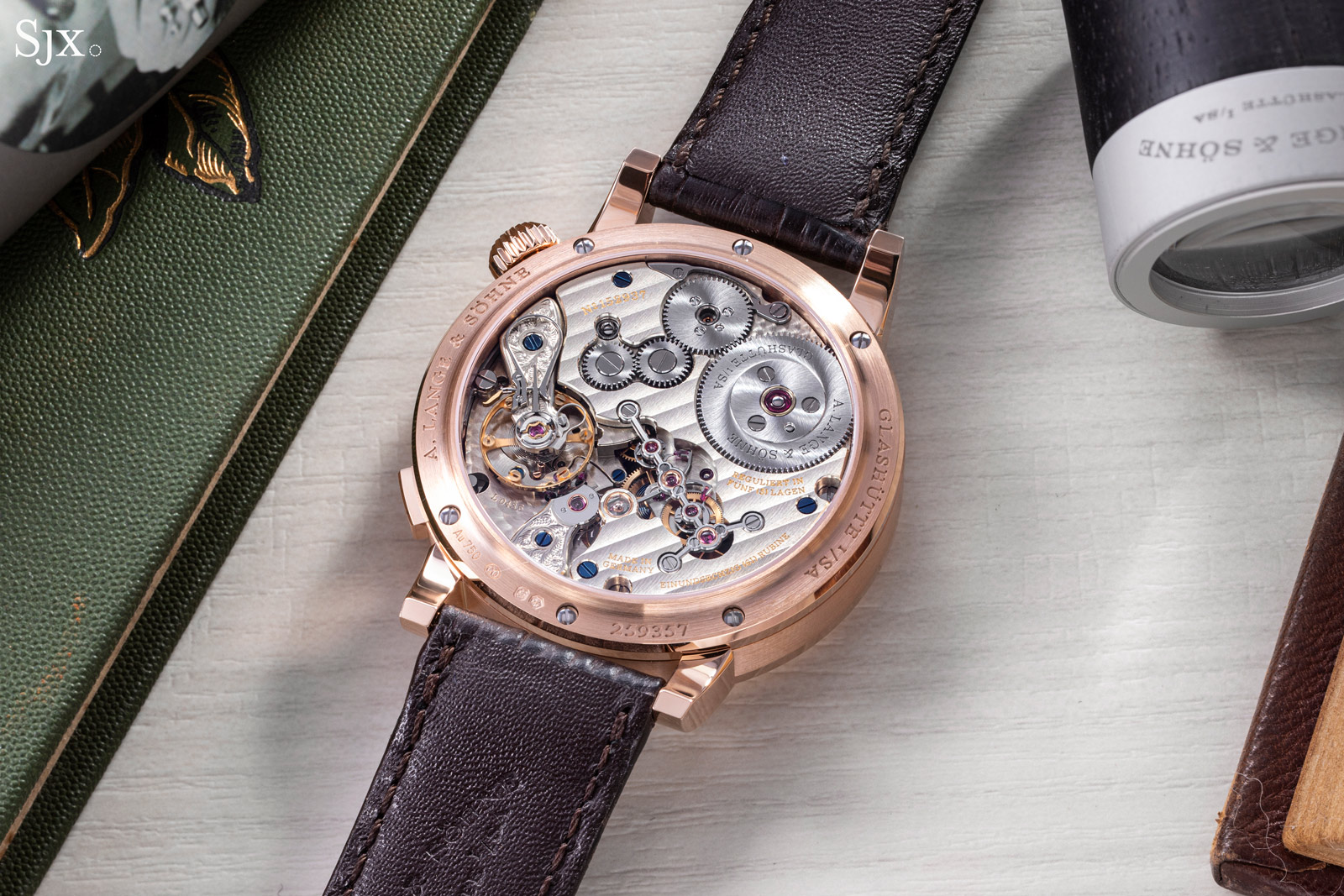
And the second-generation L043.6
Initial thoughts
In a technical sense, the new Zeitwerk is a superior watch, as it should be, coming 13 years after the original.
Aesthetically, it remains largely unchanged save for a few nips and tucks, leaving the new model instantly recognisable as a Zeitwerk. In fact, most would be hard pressed to tell the difference between the two generations from across a room.
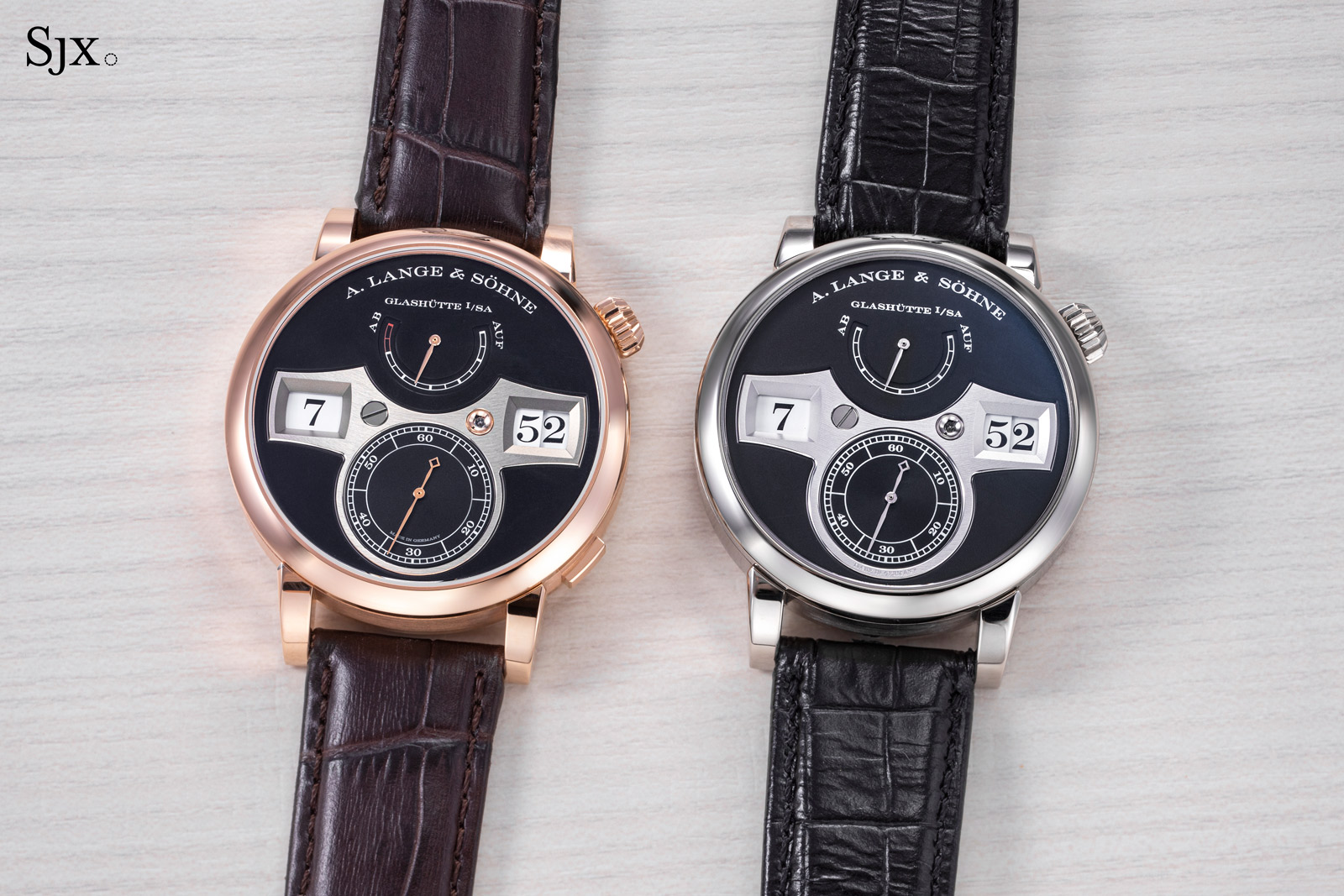
The second generation (left) and its predecessor
In the metal the new Zeitwerk looks and feels very much like the original upon initial examination. But the differences quickly become obvious, even though some, like the enlarged seconds, are subtle enough they are difficult to pinpoint.
Other tweaks are easier to spot, like the red marking on the power reserve scale. Personally I’m not a fan of the red accent since it creates a peculiar focal point on the dial, though I understand the logic of red for low power.
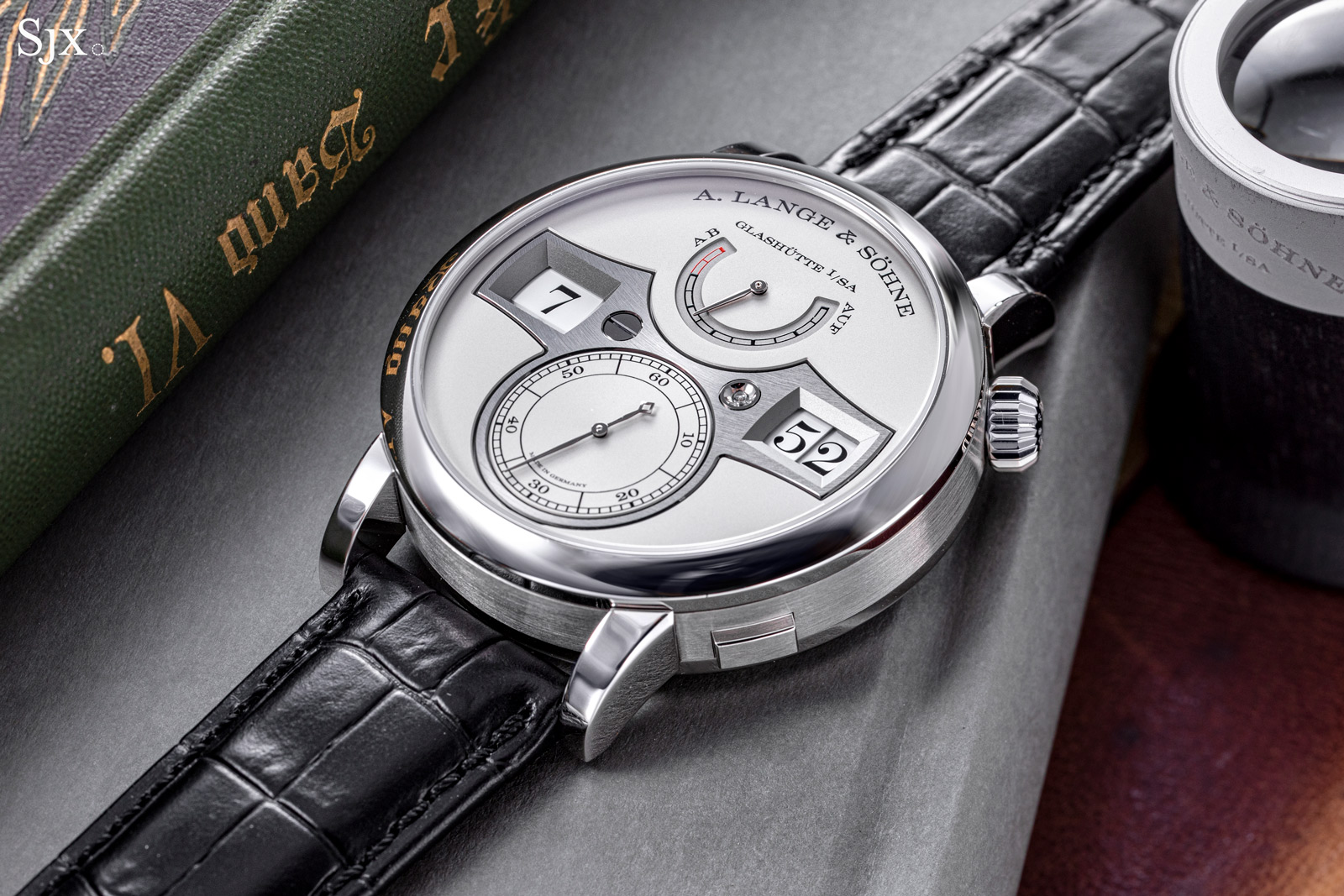
The new Zeitwerk in platinum
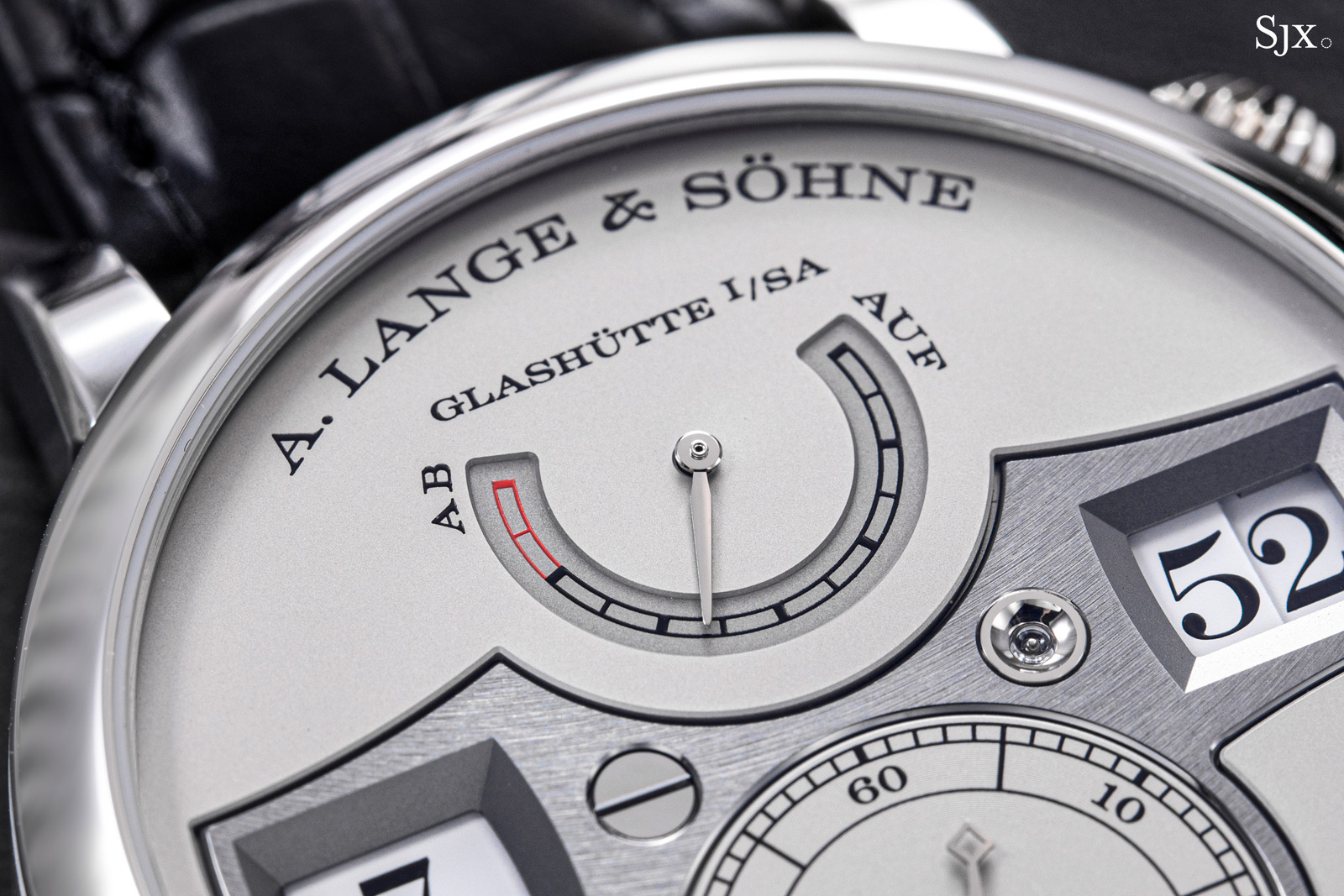
The thinness of the watch, however, feels substantial, even though it’s only 0.4 mm. That’s largely due to the fact that the reduction in height comes from the bezel, which always seemed bulbous on the original.
Despite that, the new model still feels like a Zeitwerk – it’s a large, weighty watch as most Lange timepieces are, but it is just a tiny bit sleeker than the original.
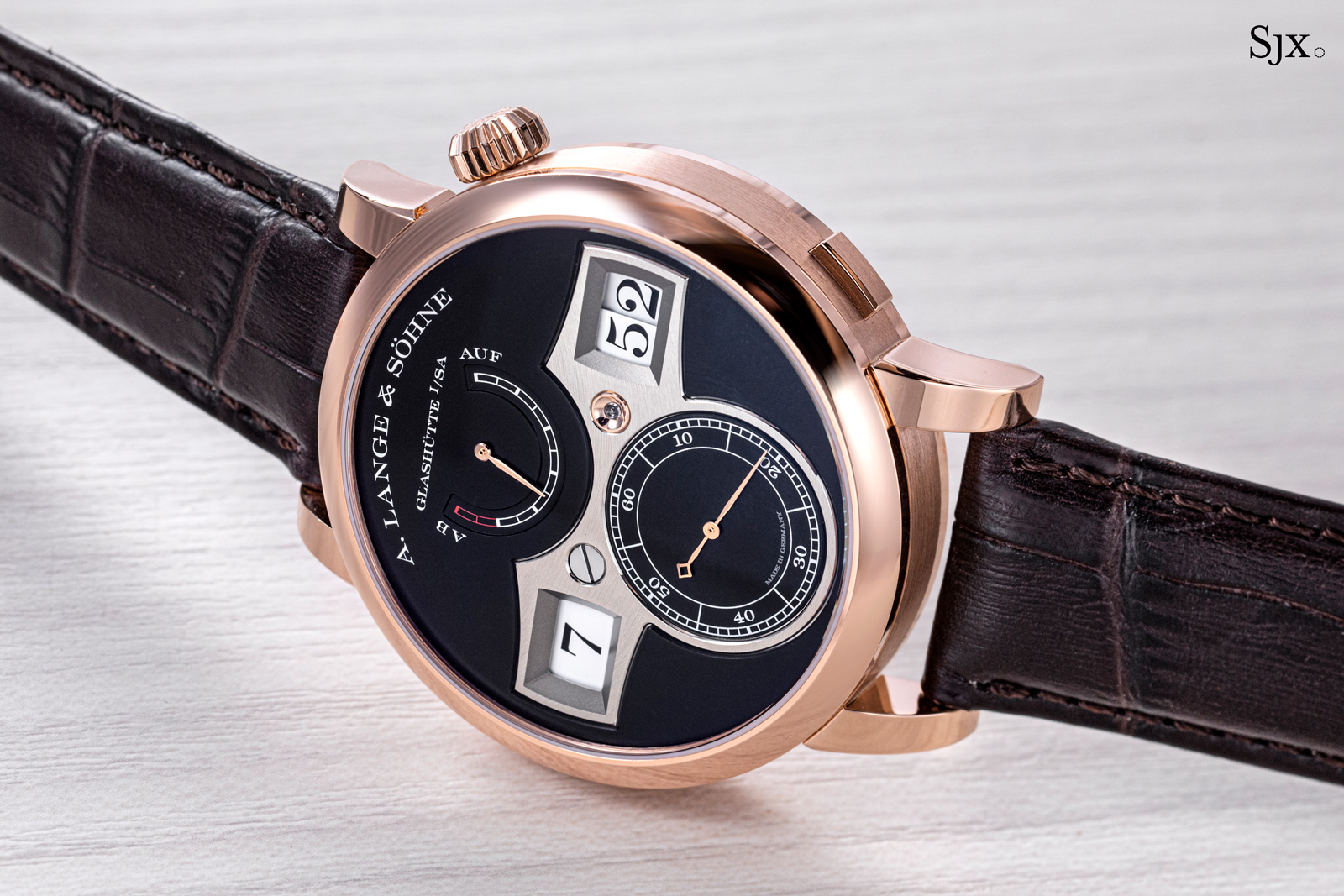
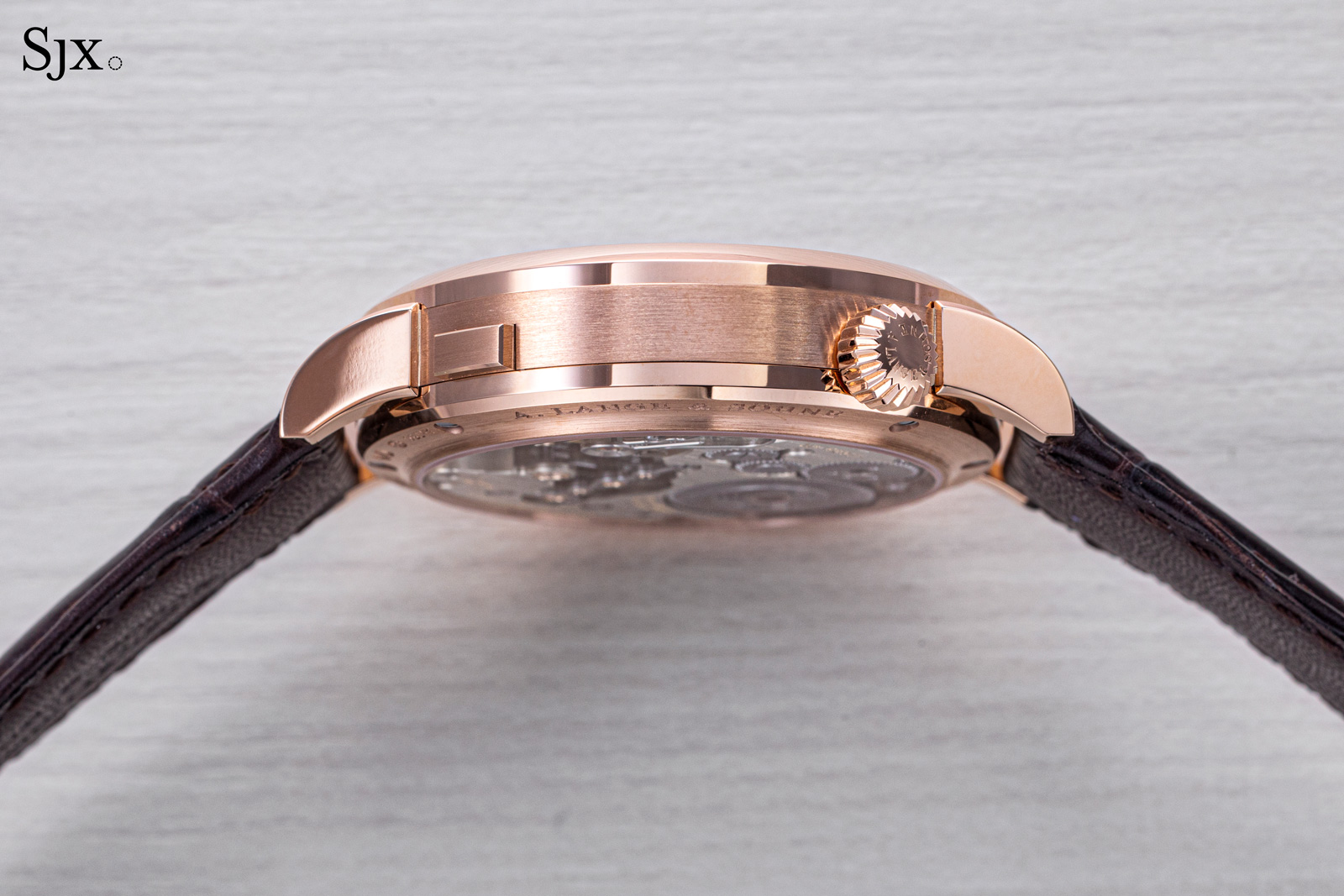
The new model is 12.2 mm high, a seemingly modest reduction in height but one that makes a difference
The movement is undoubtedly better in terms of function and the same can be said of its aesthetics, though the complexity of decoration might divide opinion. While the first-generation movement had an almost chaotic design – exemplified by the crooked remontoir bridge – the new calibre has a cleaner, more coherent style.
Most of the changes, in short, are improvements in both design and function – they contribute to a better watch. The practical improvements are enough that the new model is arguably a worthwhile upgrade even for the owner of a first-generation model.
At the same time, the new Zeitwerk feels similar enough to the original that anyone familiar with the original will still be comfortable. Not much of a difference is noticeable on the wrist, except for the utility offered by the new features.
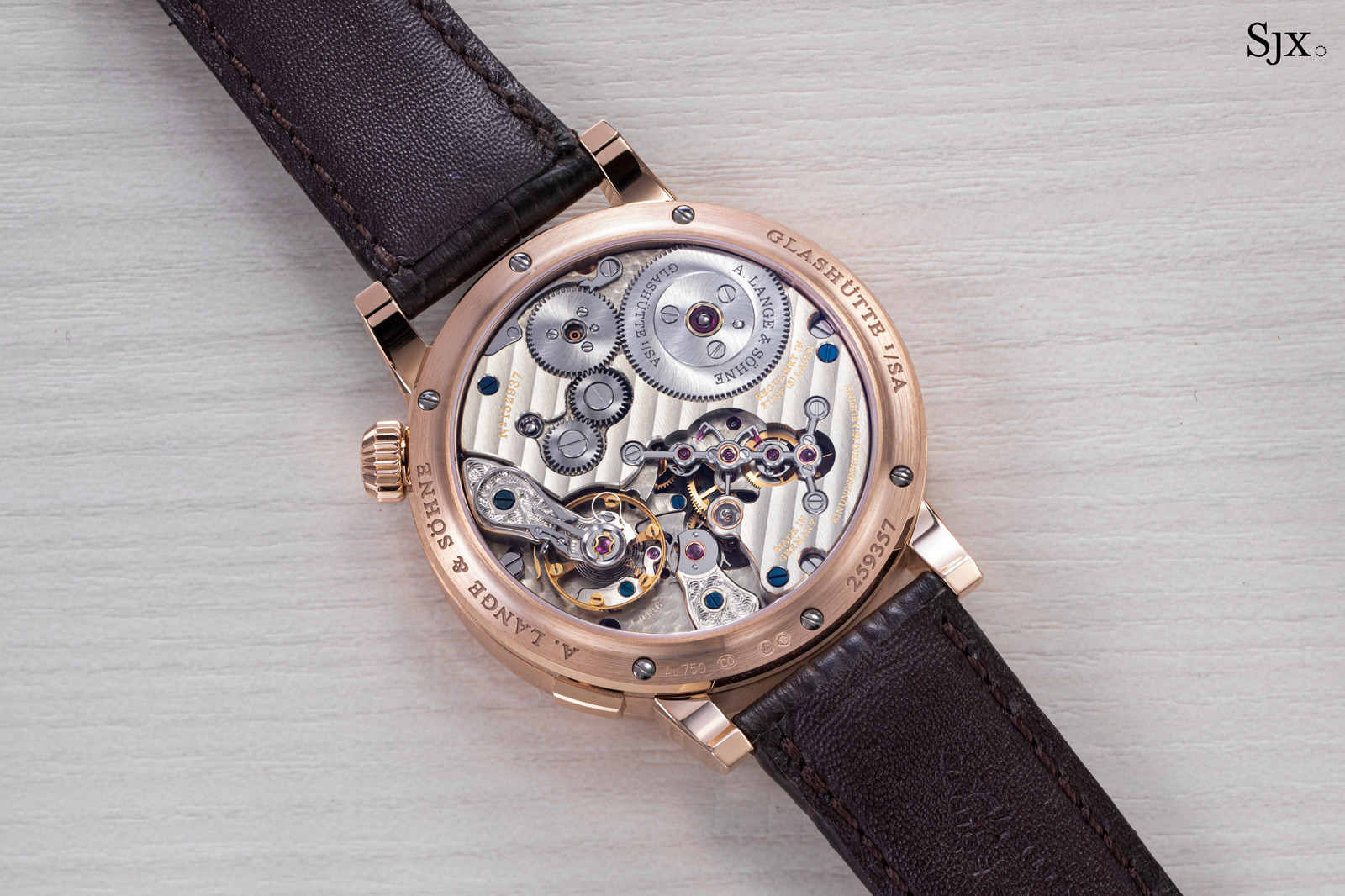
The new L043.6 with its straight remontoir bridge
On a separate note, it’s worth noting the seemingly sparse choices on offer. In contrast to the original model that was available in four variants, the new Zeitwerk makes it debut in only two – a conventional platinum with silver dial and a more unusual pink gold matched with a black dial.
The rationale of the pink gold version is probably to appeal to those who missed out on the Zeitwerk Honeygold Lumen, which has a similar palette. In fact, at a distance both look almost the same.
Given that the white-gold-black-dial variant of the original Zeitwerk was probably the most popular, it’s peculiar that the combination isn’t in the catalogue anymore. But commercial logic dictates a variant of the white gold model with a dark dial, maybe blue or grey, is surely in the pipeline.
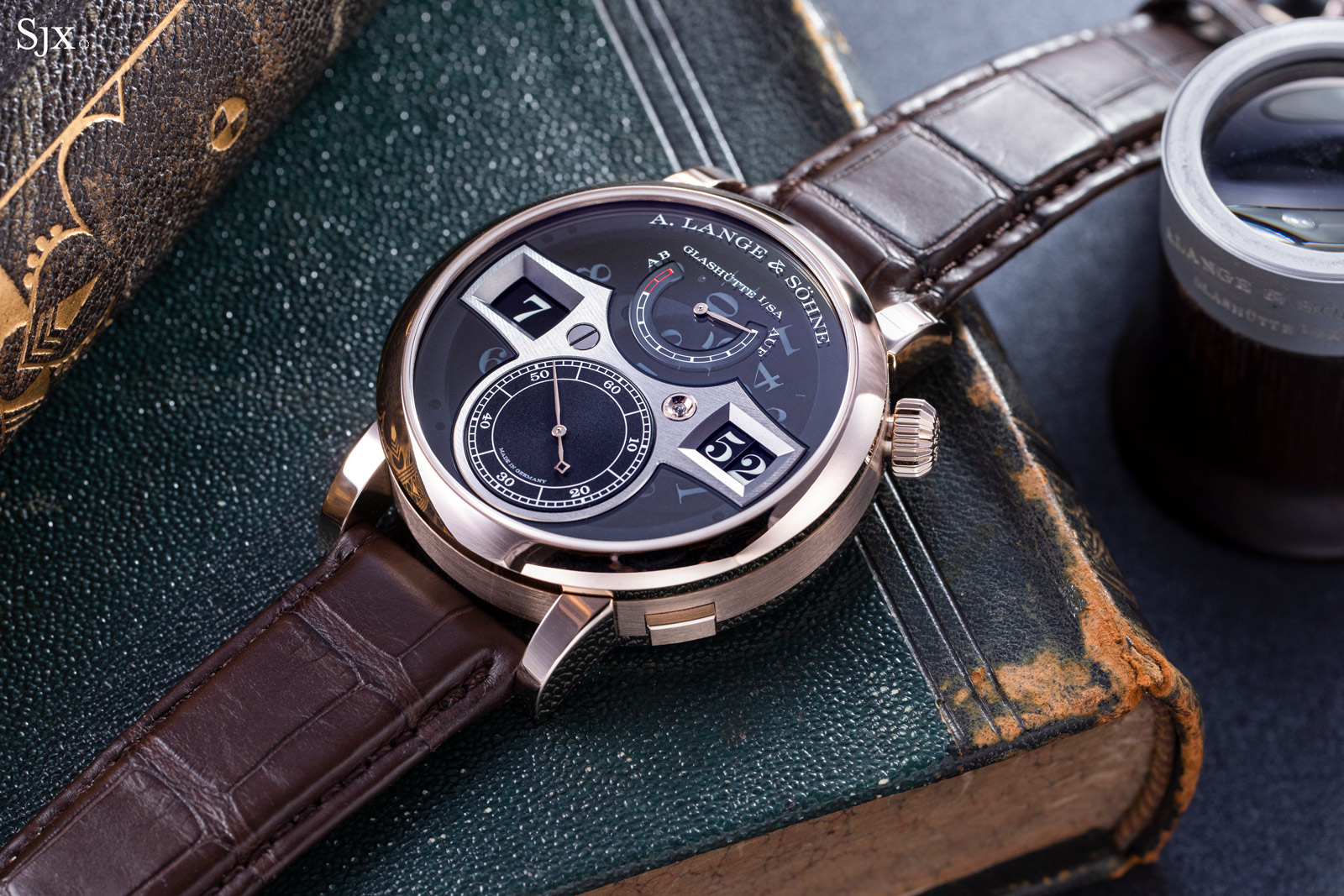
The Zeitwerk Honeygold Lumen
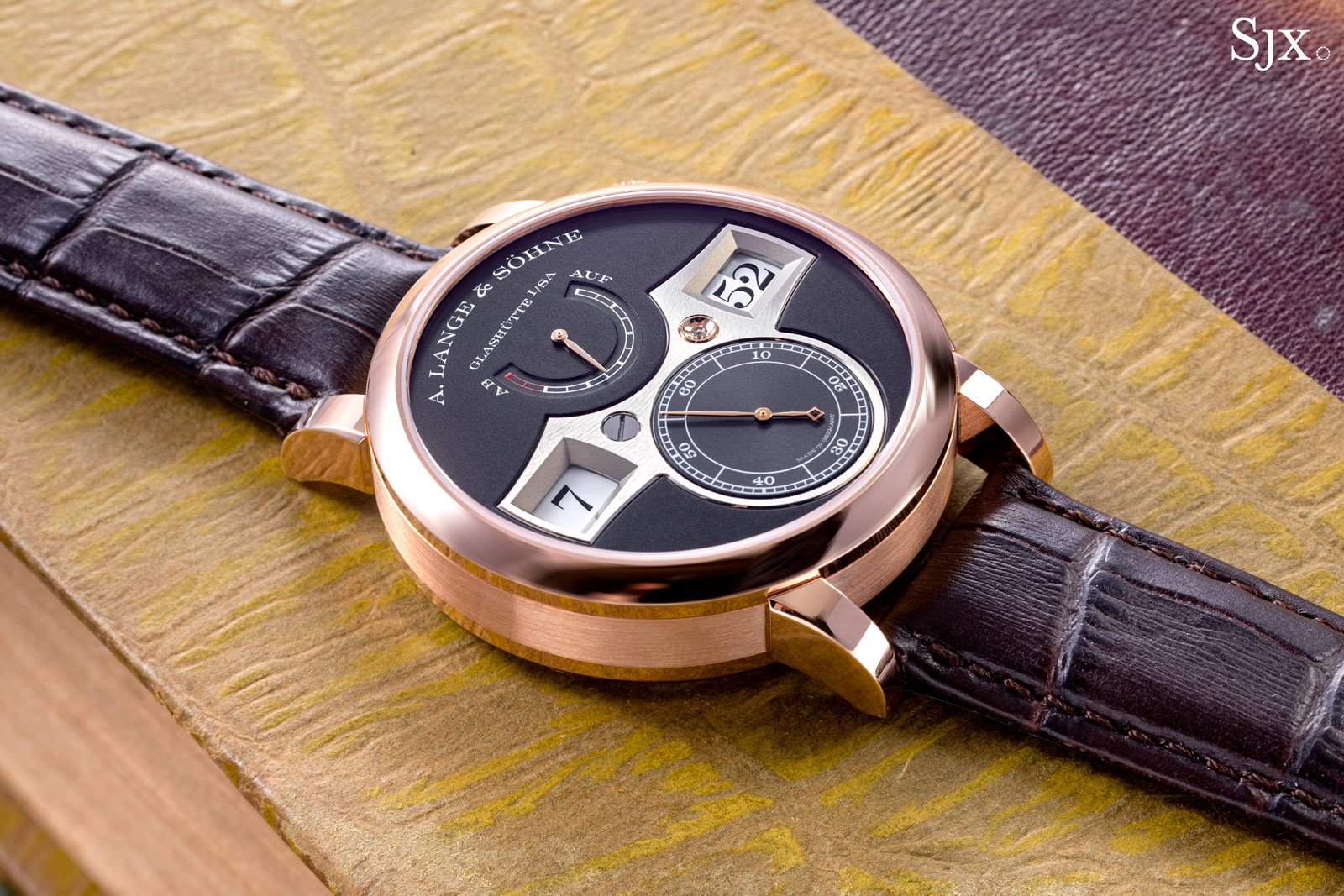
The new Zeitwerk in pink gold
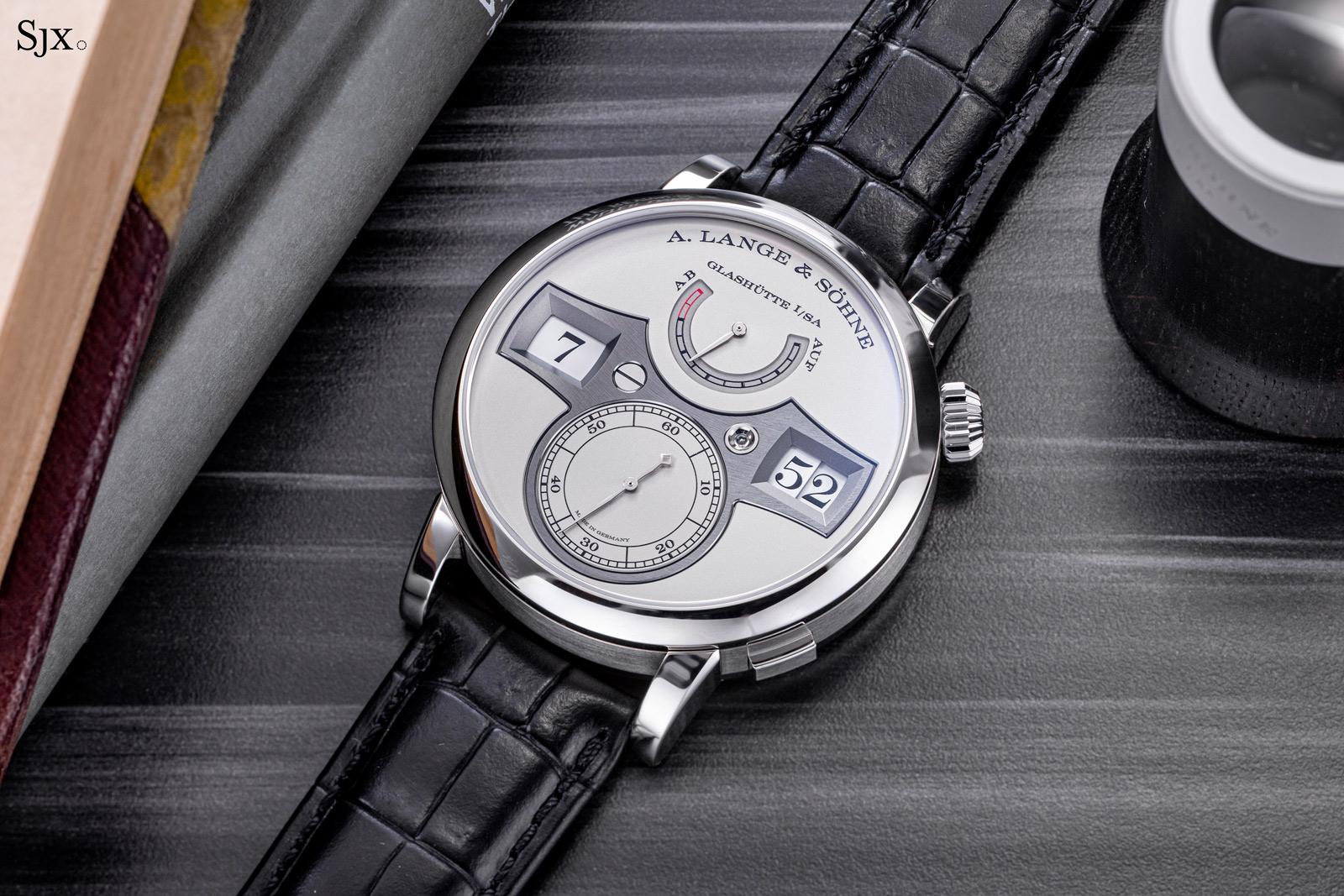
And in restrained platinum
Gently evolving
Side by side both generations of Zeitwerk are clearly similar but distinct. The visual changes from one generation are modest but enough that the the two can be distinguished at arm’s length.
Perhaps the most significant change is the case thickness. The new Zeitwerk is just 12.2 mm high, compared to 12.6 mm for its predecessor, a notable achievement considering the twofold increase in power reserve.
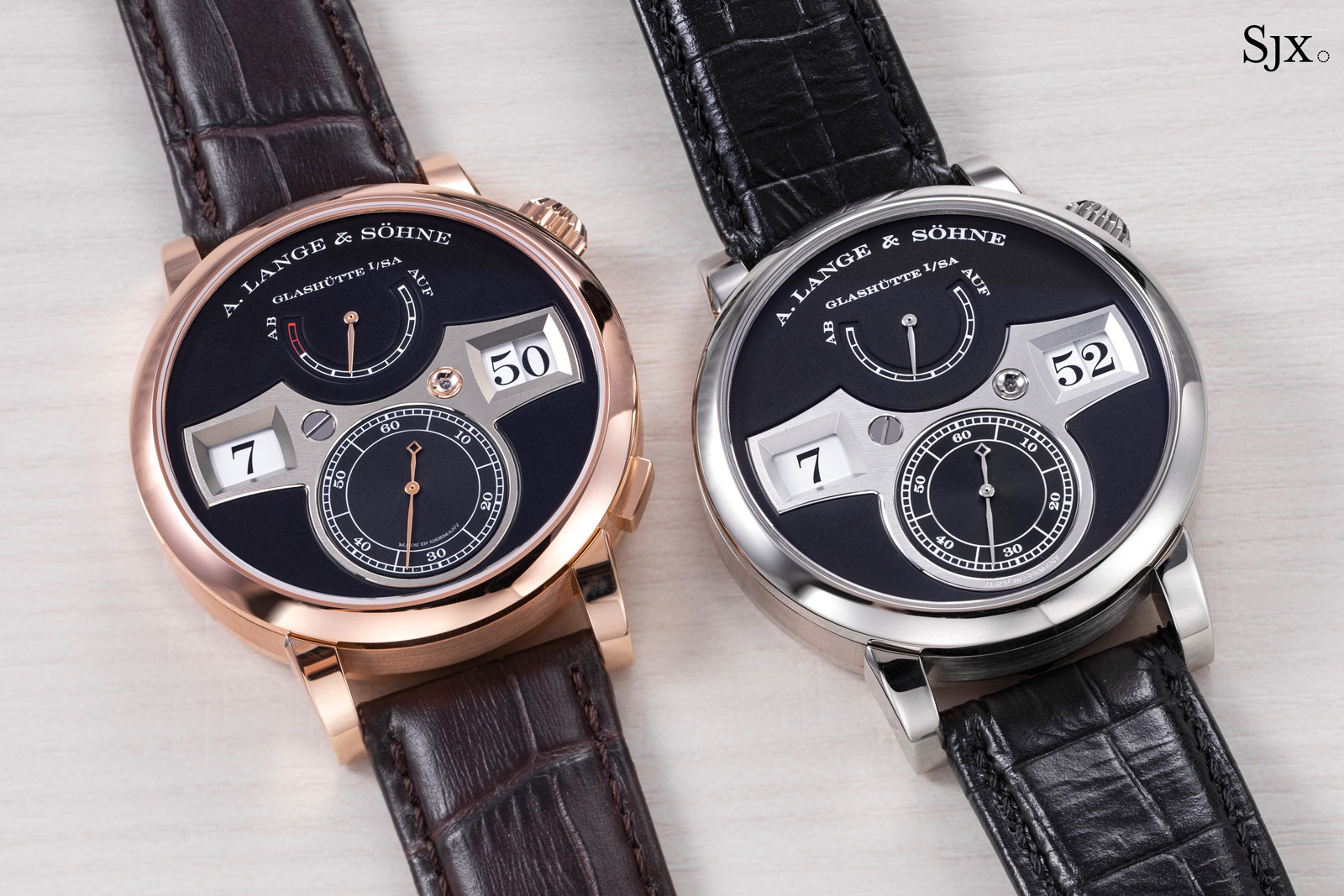
The new (left) and old
The reduction in height comes entirely from a flatter bezel; the case middle and back remain the same on both generations.
But that single component has a major impact on the perceived size and thickness of the watch. The flatter, slightly less domed bezel gives the new Zeitwerk a very different look and feel. Placed side by side with the original, the new Zeitwerk looks and feels almost svelte. The original, in contrast, suffers from a domed bezel that emphasis its bulk.
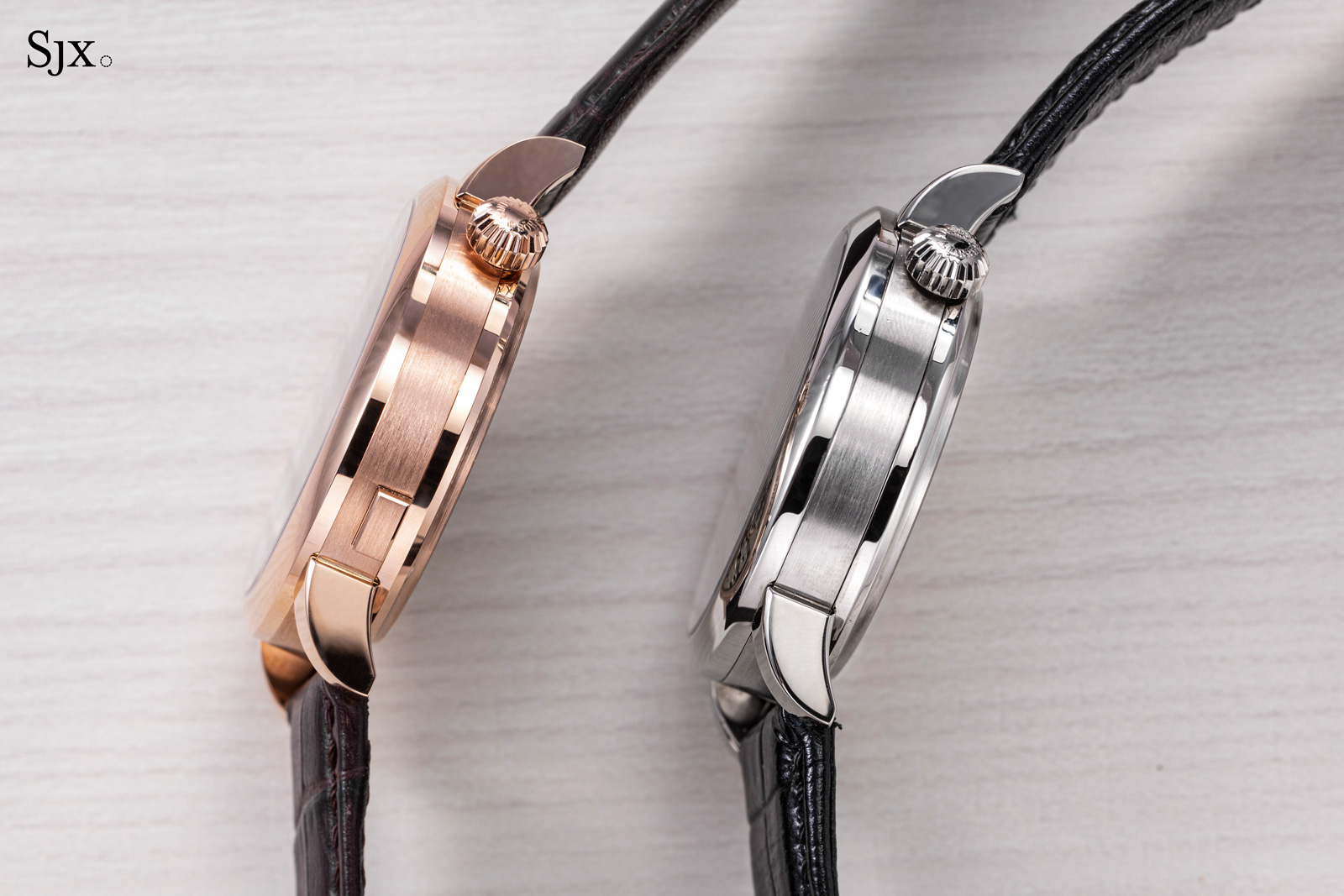
The new at 12.2 mm (left) and original at 12.6 mm
Another visible change is the addition of the pusher at four o’clock for advancing the hours. The button serves and eminently useful purpose since setting the time no longer requires cycling through 60 minutes repeatedly to set the hours. But it does interrupt the lines of the case. Personally I would happily sacrifice the utility of a quickset hours for a cleaner outline.
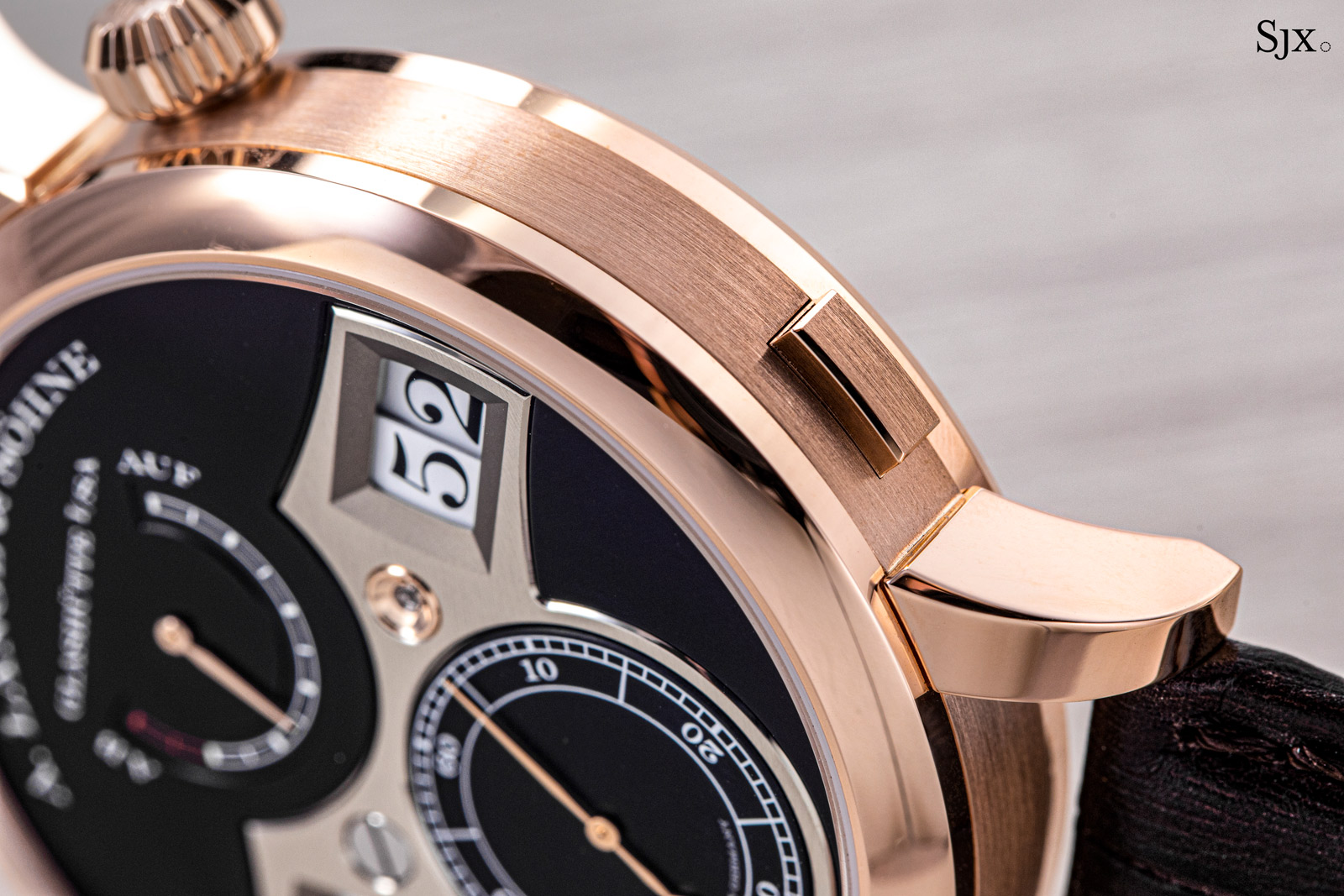
Less apparent but important to the visual refinement is the enlarged seconds register. It’s imperceptibly larger, but makes all the difference in giving the dial better proportions.
Paradoxically, despite being a fairly subtle change on its own, the enlarged seconds makes a big difference to the appearance of the dial because it reduces the footprint of the “winged” bridge for the time display. The slimmer bridge improves the appearance of the dial, as does the enlarged seconds, which is now more prominent than the power reserve indicator.
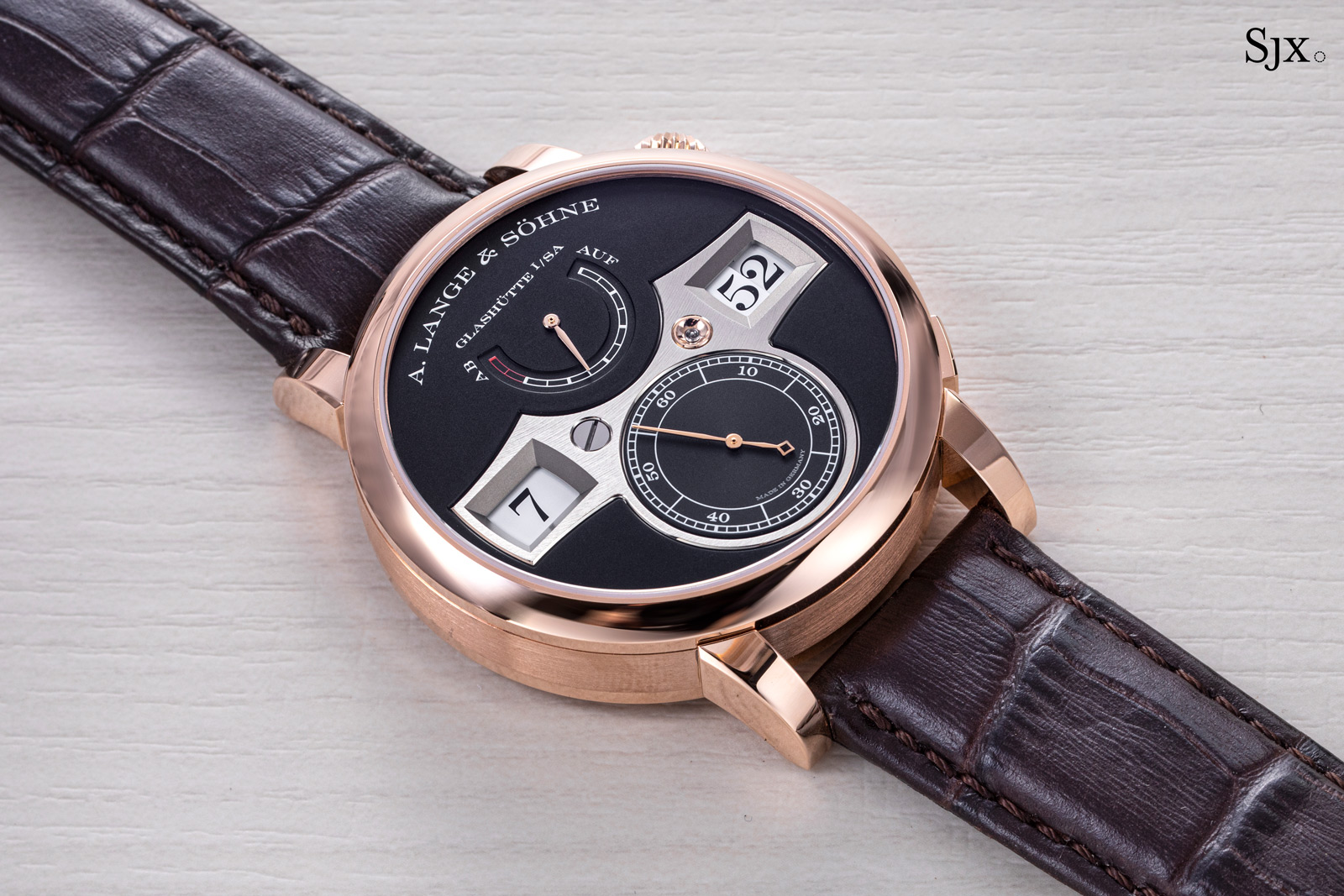
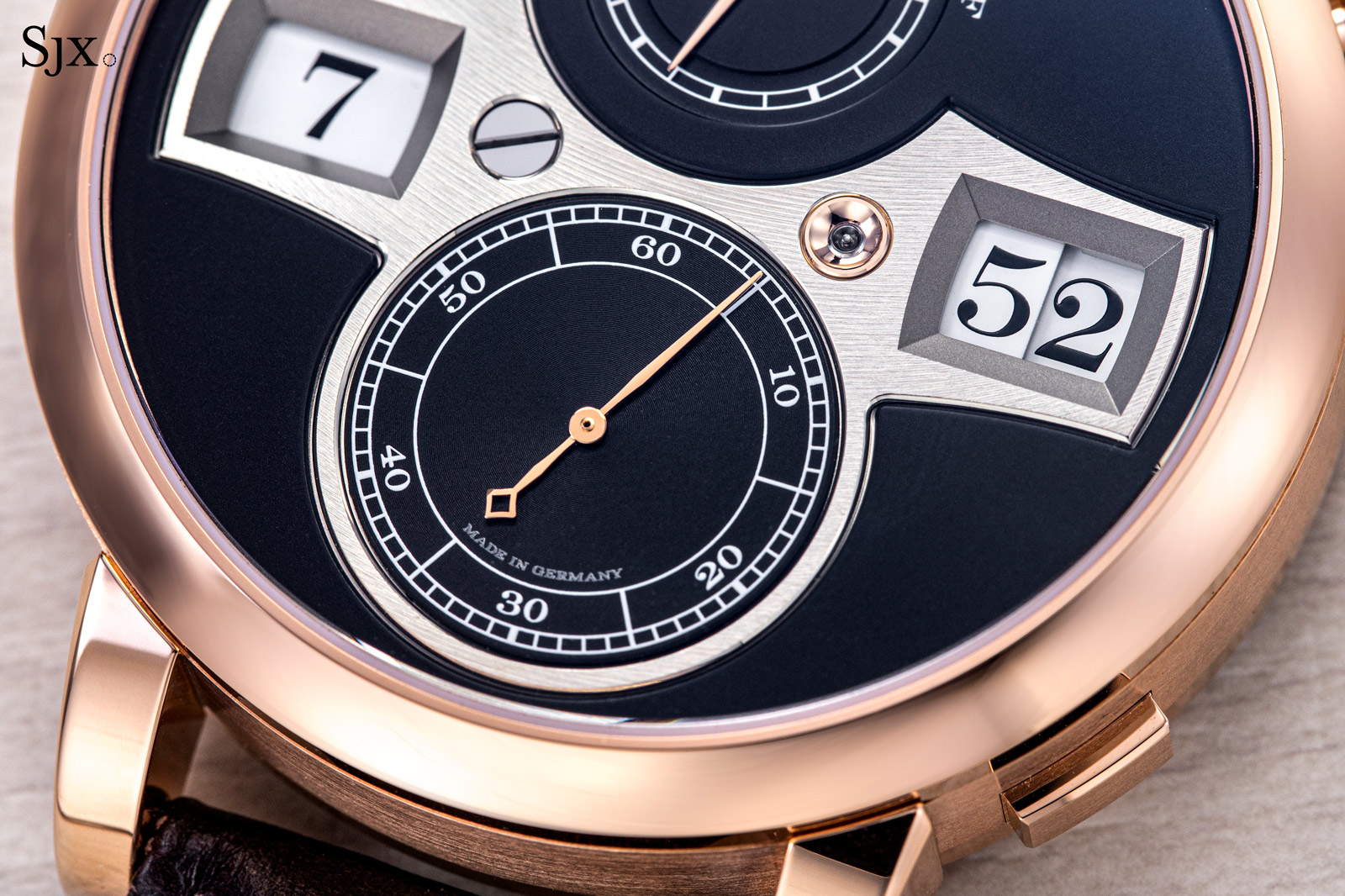
The increased diameter of the seconds narrow the “wing” bridge around it
In the earlier version, the seconds and power reserve were similar in scale. The new layout is more logical since the seconds are arguably more important for the wearer than the power reserve display (which is only needed once every three days when the movement needs winding).
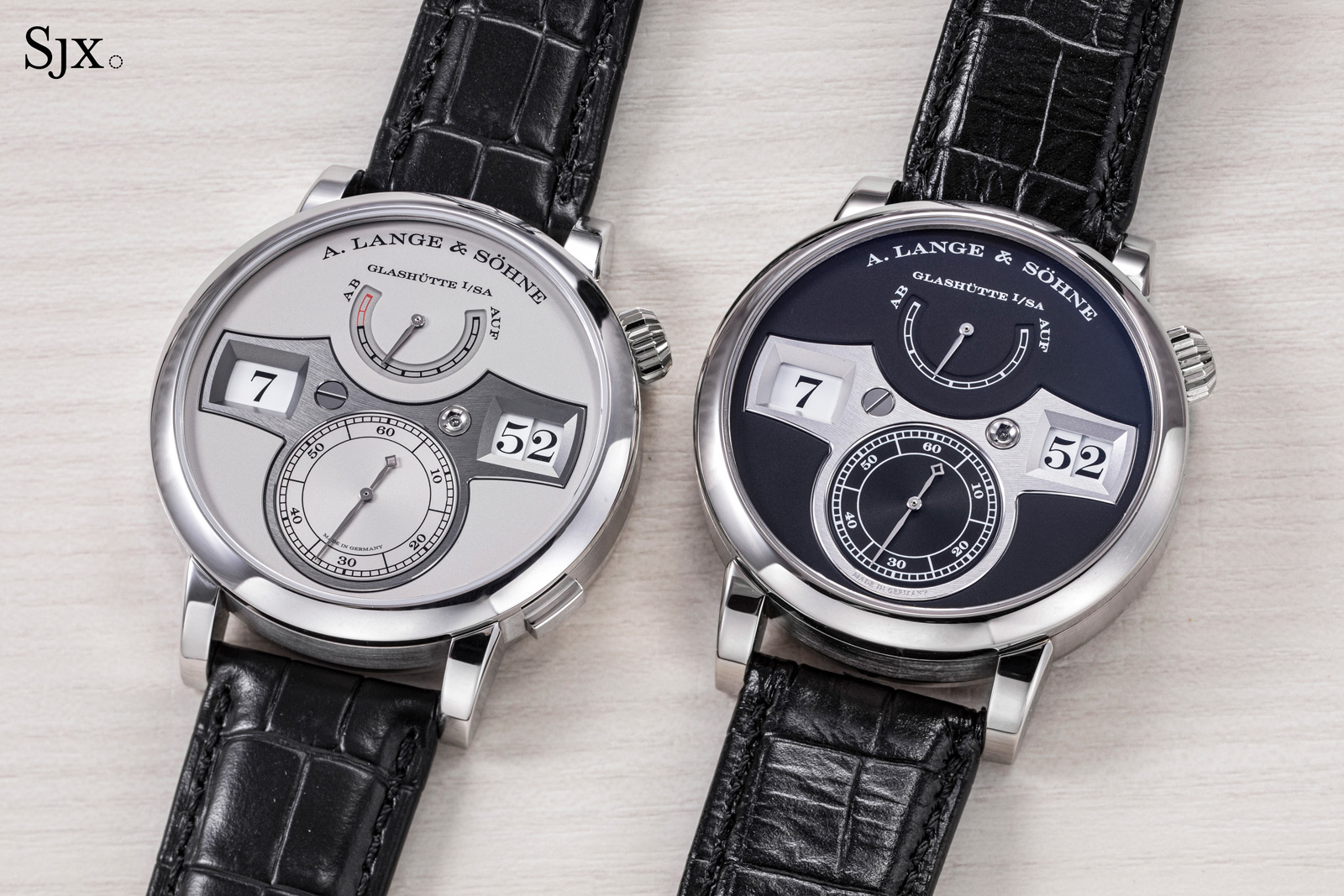
The new model with its larger seconds (left), against the original, but both have identical power reserve scales
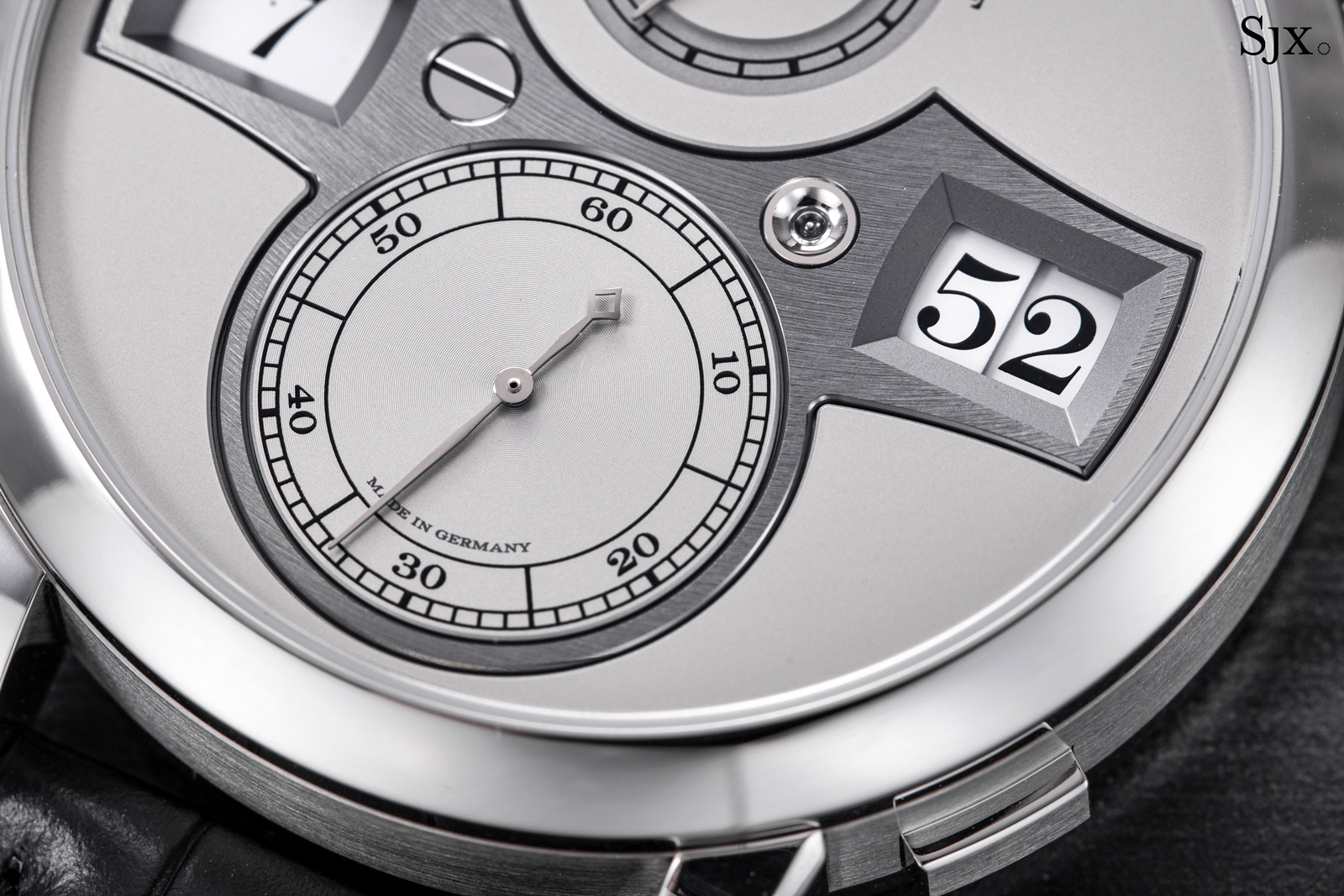
Despite being less prominent, the power reserve indicator is the same size as that of the original model. But it displays differently since it now indicates a long running time. Each hashmark on the scale represents six hours instead of three hours on the original.
The red accent at the empty end of the scale serves as a reminder that winding is necessary, although I am not a fan of the red accent as it jumps out on an otherwise low-key dial. On the pink gold model the red accent is more acceptable since it echoes the rosy hue of the case, but on the monochromatic platinum version it is too conspicuous.
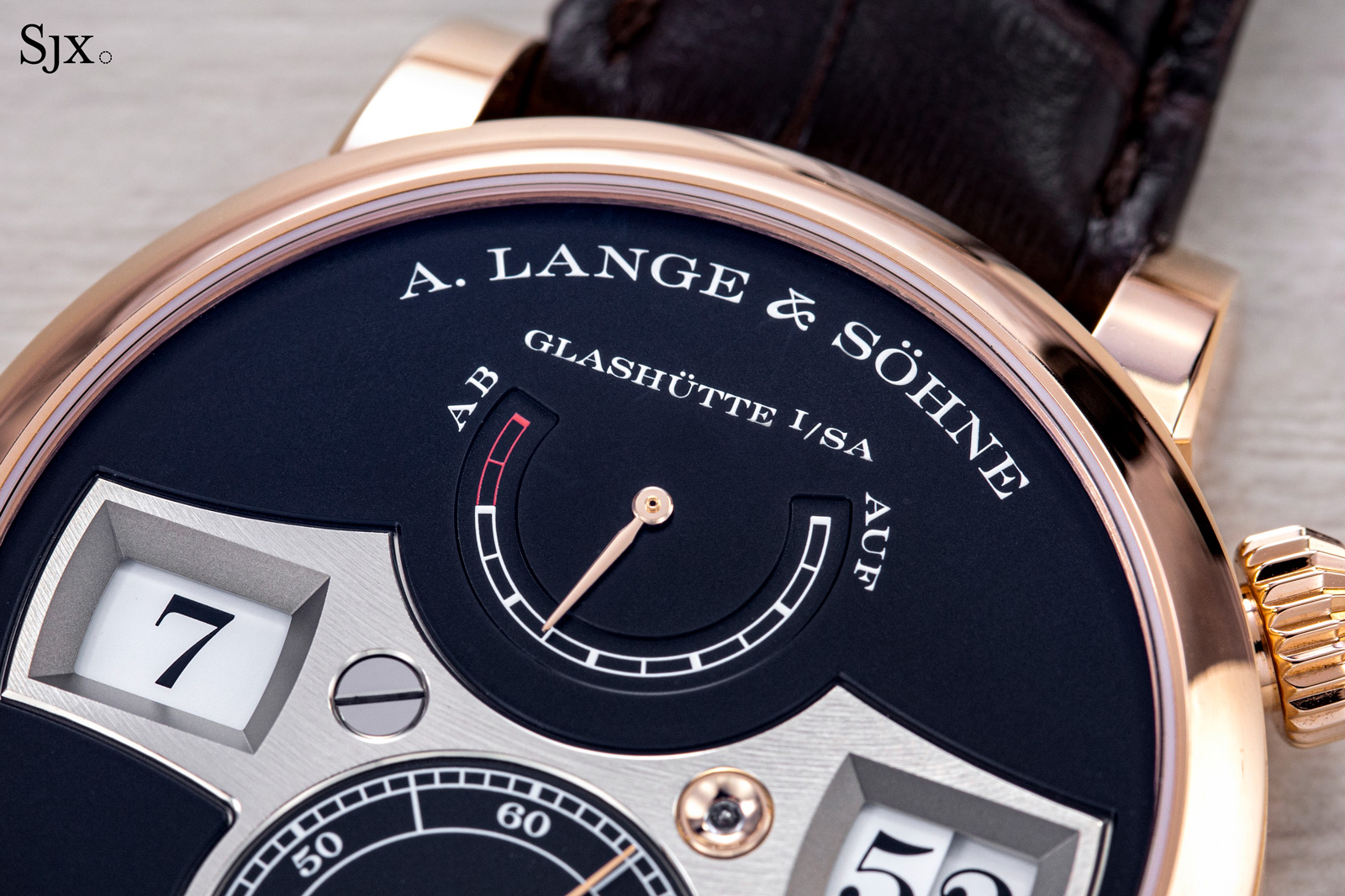
The 12 hashmarks on the power reserve scale now add up to 72 hours
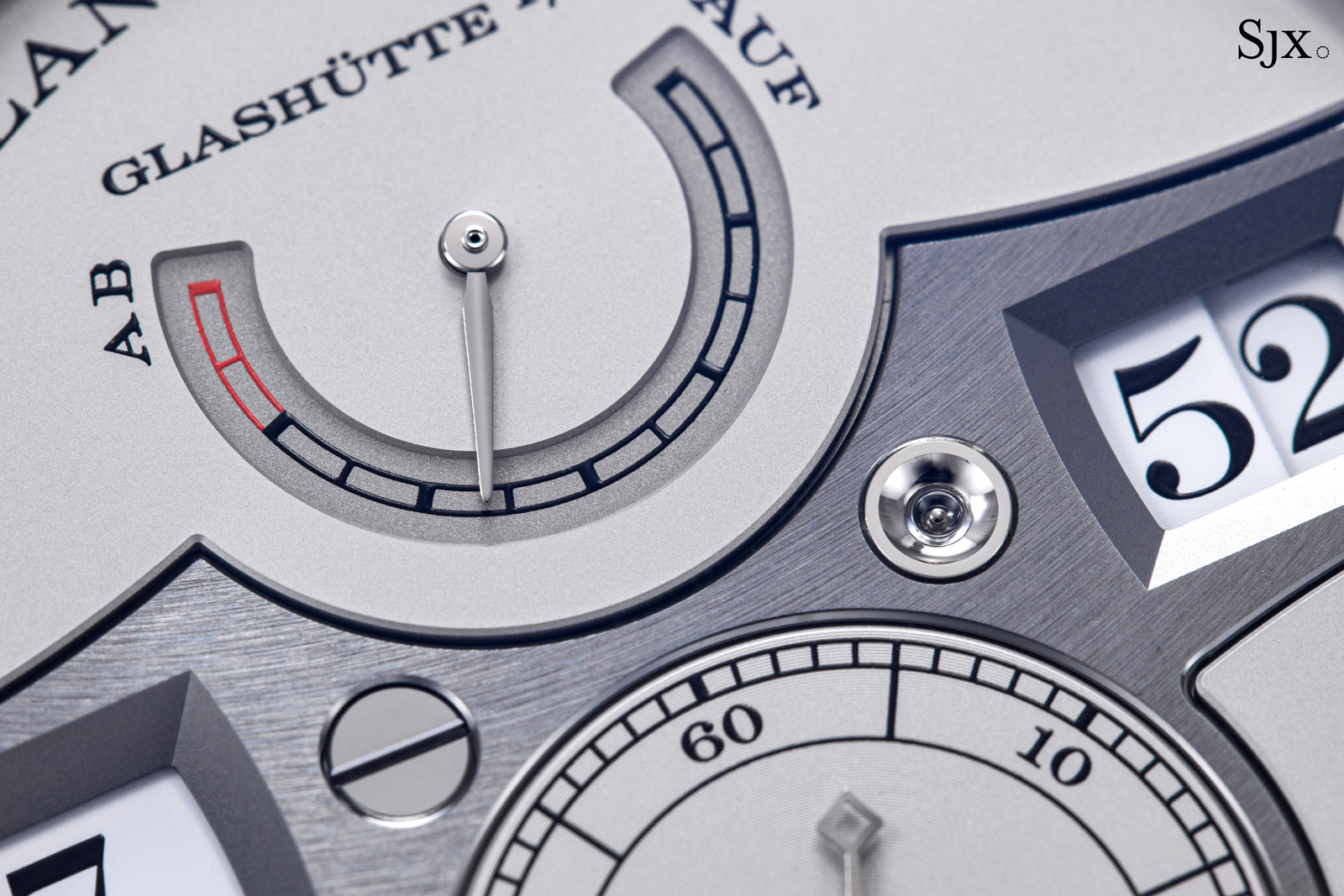
The final two segments of the scale in red represent the final 12 hours of running time
Refined mechanics
The back of the watch is where the differences between the two generations are realised in a tangible, mechanical sense. Visible through the open back of the new Zeitwerk is the L043.6, a calibre that shares the same base as the Zeitwerk Date that’s powered by the L043.8.
As an aside, much can be discerned from the movement name, “L043.6”. The “.6” suffix implies the movement is the sixth development of the L043 (though movements are not released in chronological order). Naturally, the movement of the very first Zeitwerk was the cal. L043.1.
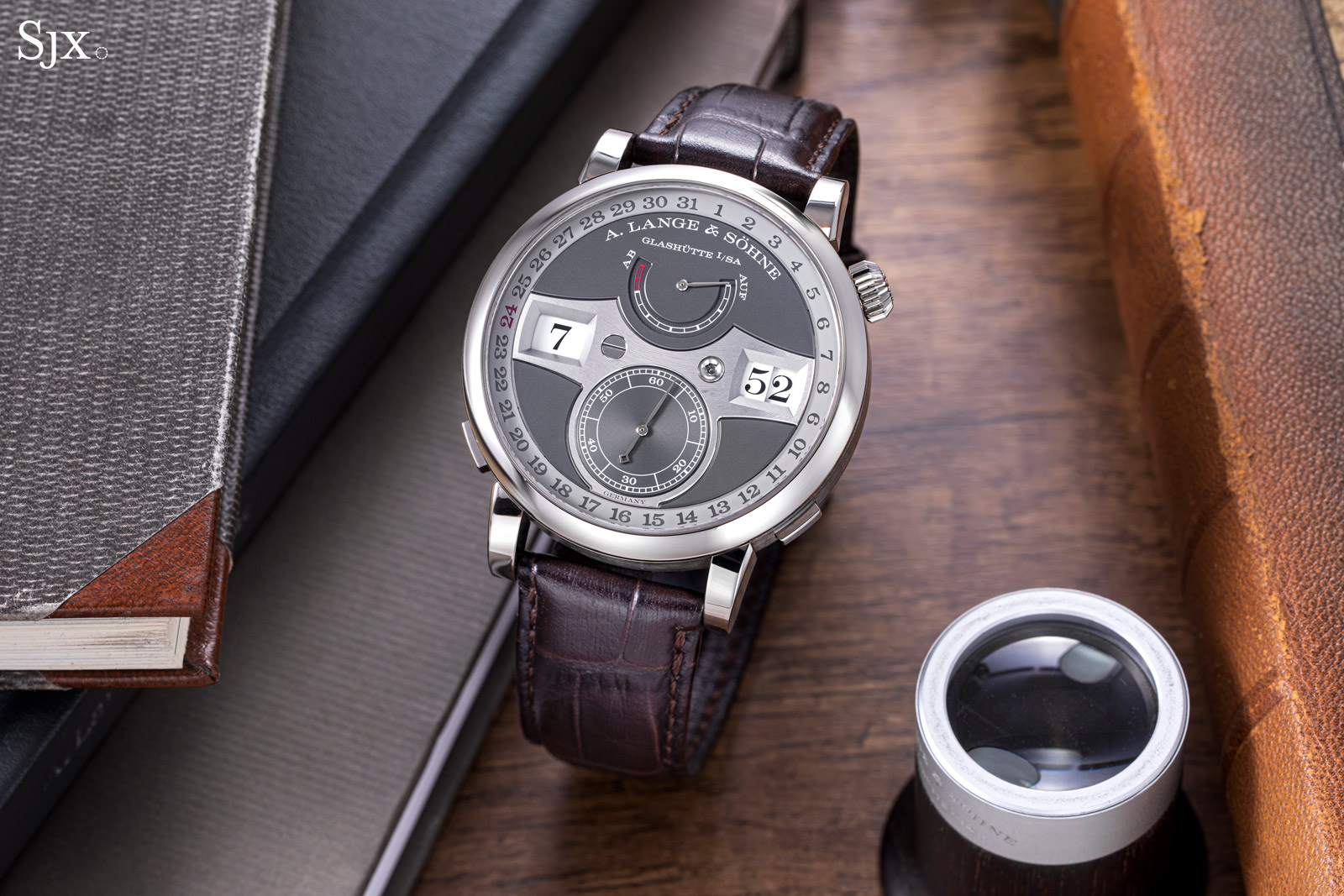
The Zeitwerk Date that was launched in 2019
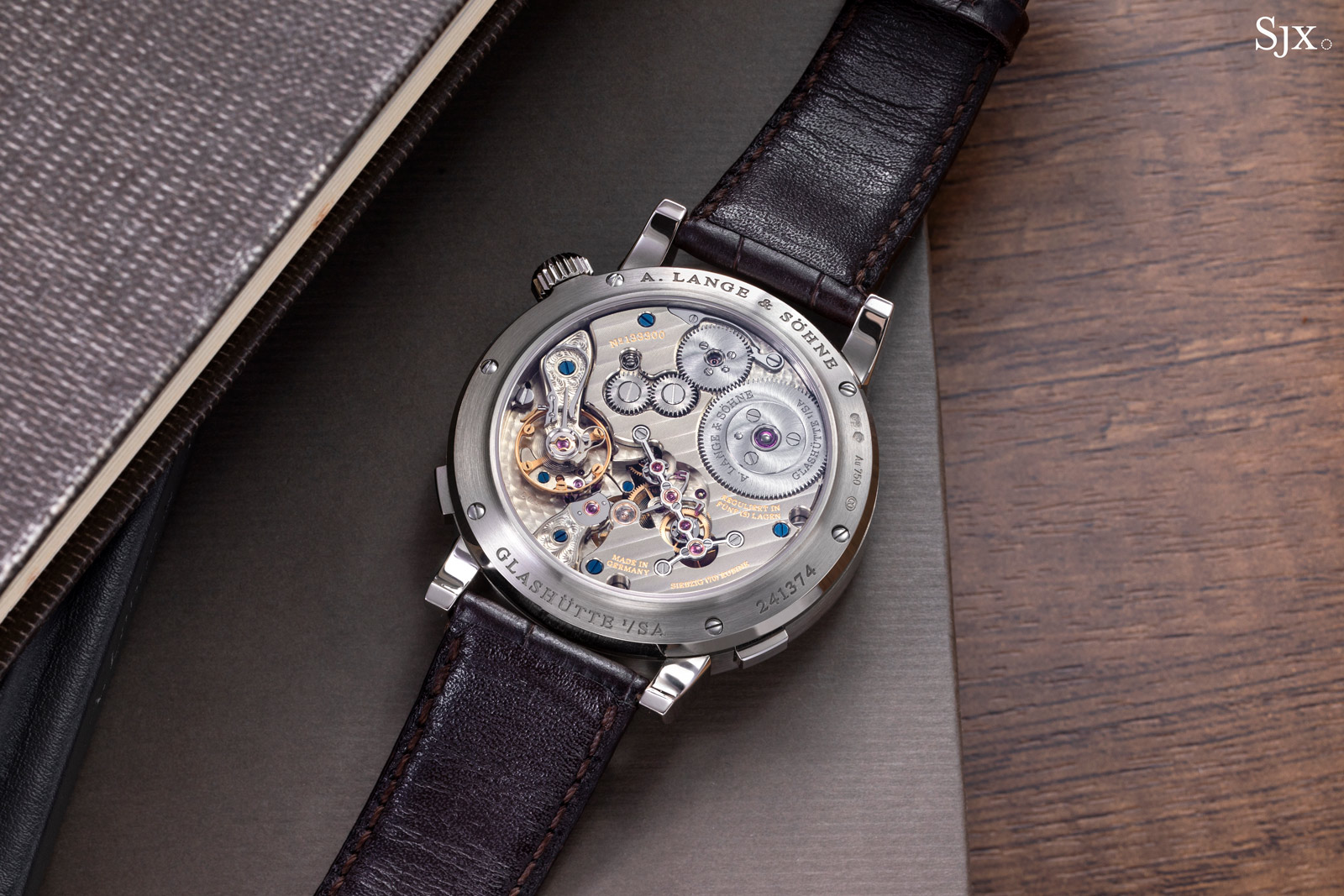
It was the first model with a second-generation movement, specifically the L043.8
And continuing conventional Lange nomenclature, the “043” prefix indicates development of the movement was started in 2004 – and it was the third movement developed that year. Much has changed in the intervening 18 years.
As a result, even though all Zeitwerk models from 2009 till now are powered by L043.X movements, the calibres can be categorised into two distinct generations that are different enough that key components are not interchangeable between the two. As a result, not only are the two generations different in terms of aesthetics, the second generation has numerous technical upgrades over its predecessor.
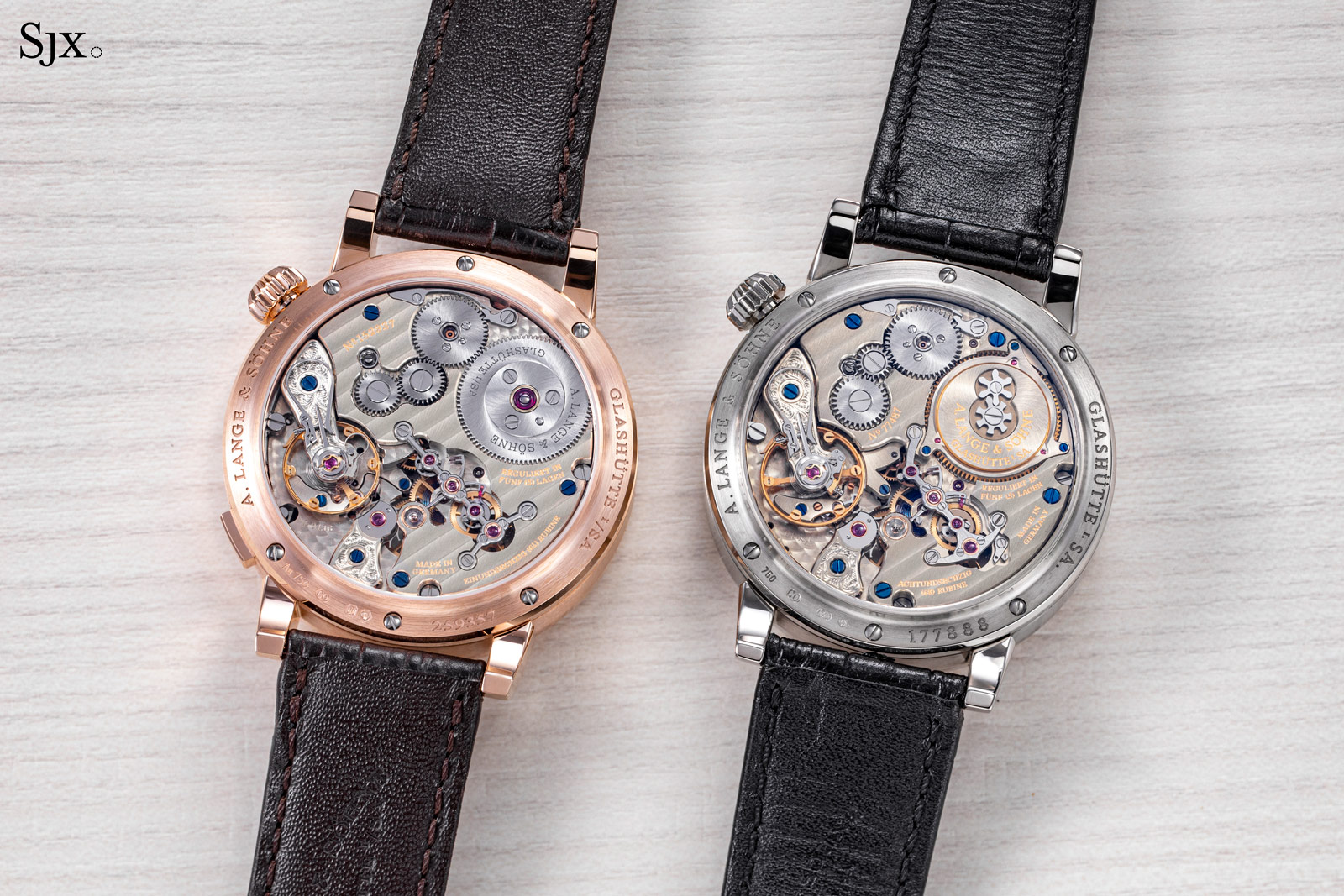
The L043.6 of the new Zeitwerk (left), compared with the L043.1 of the original from 2009
The first generation base movement is identical across all models up to, but not including, the Zeitwerk Date, from the base model to the top-of-the-line the minute repeater.
Meanwhile, the Zeitwerk Date signified the beginning of the second generation base movement when it made its debut in 2019 with the L043.8. It took three years for a base-model Zeitwerk with the updated base movement to make it to market, a delay perhaps caused by the pandemic.
The new Zeitwerk movement is identical to that found in the Zeitwerk Date, but without the date mechanism.
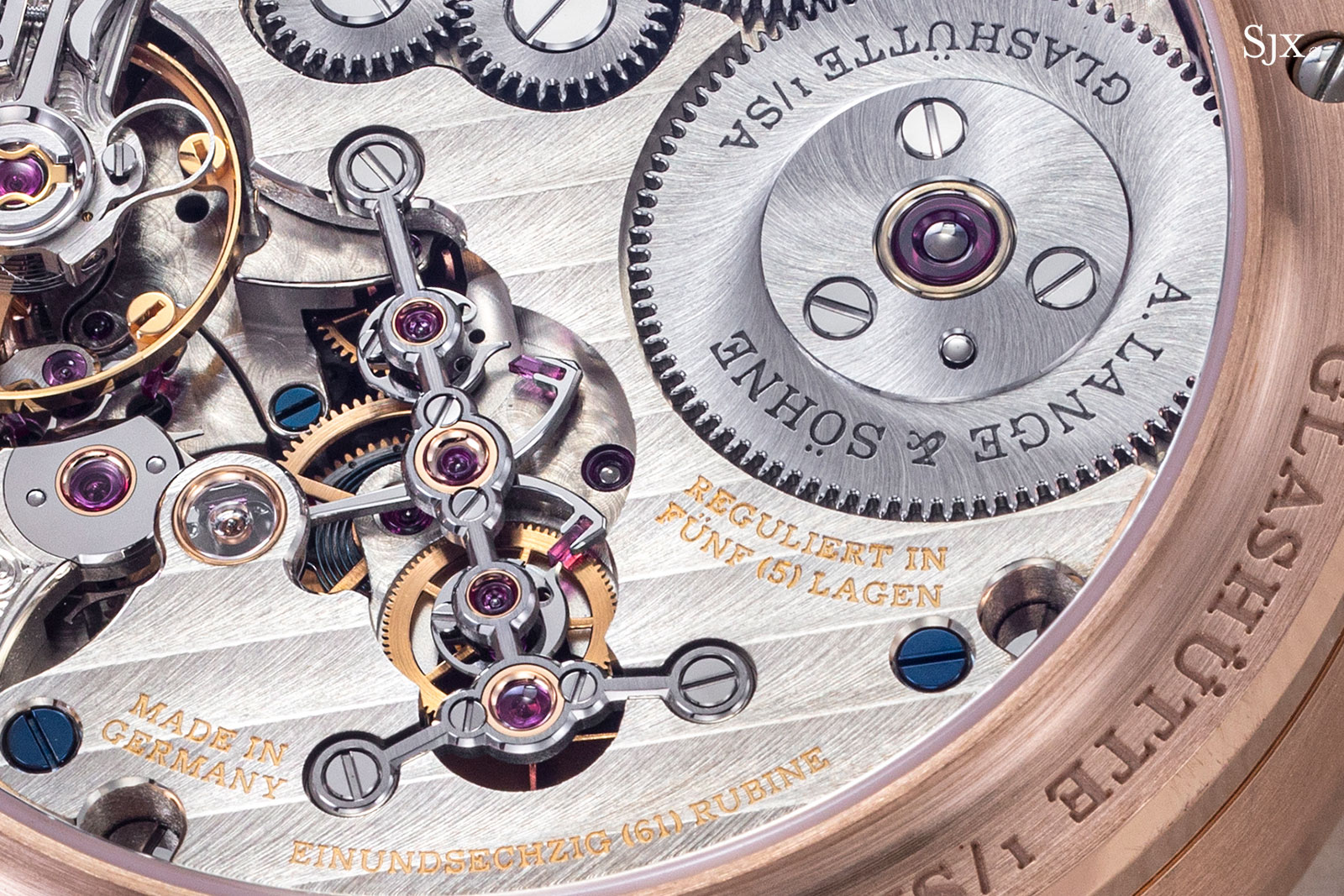
The straight remontoir bridge that signifies a second-generation Zeitwerk movement
Quickset hours
The most tangible upgrade to the new Zeitwerk is the quickset hours that can be advanced by the pusher at four o’clock. On its face a dedicated pusher solely for the hours seems odd, but in context it makes sense in several respects.
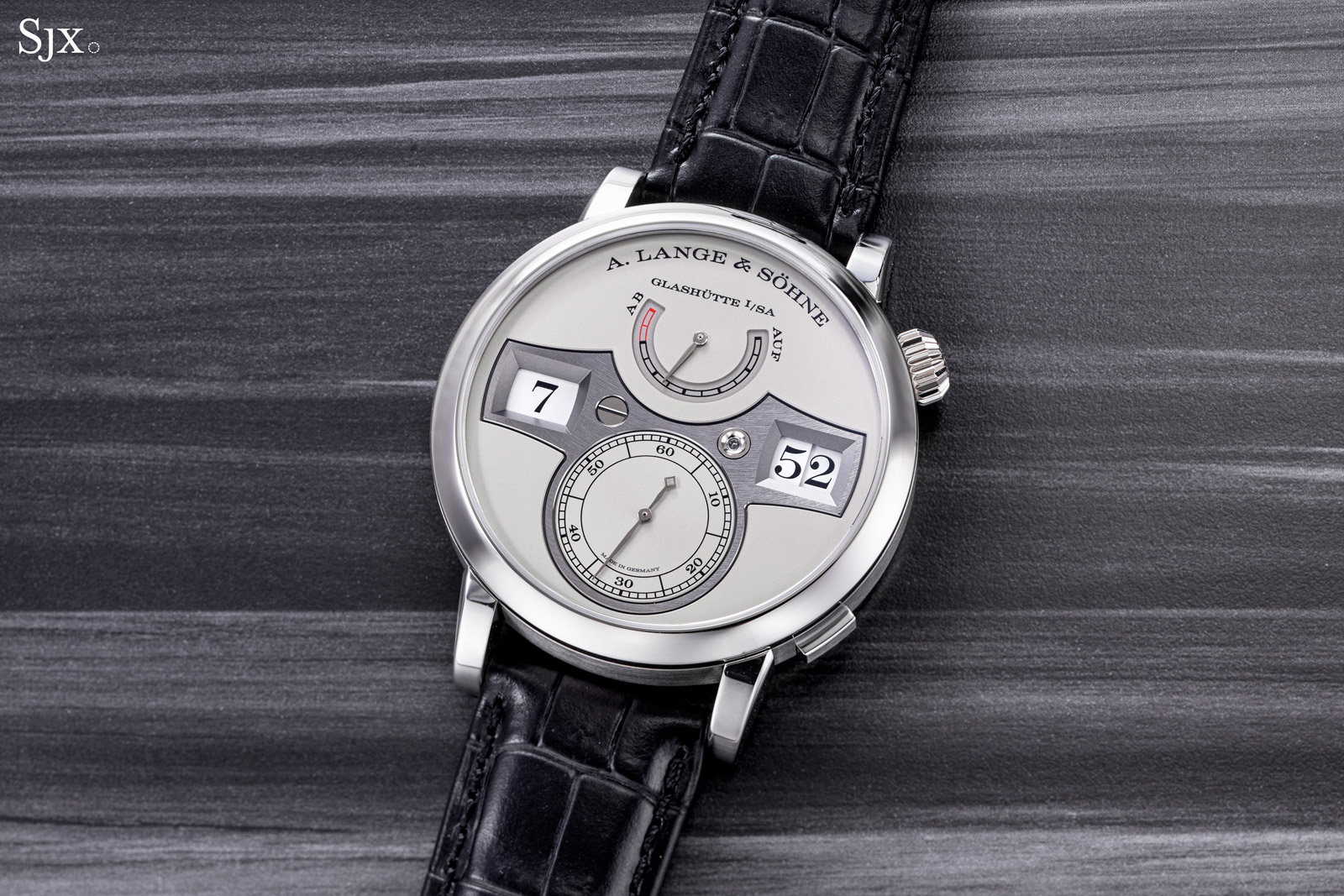
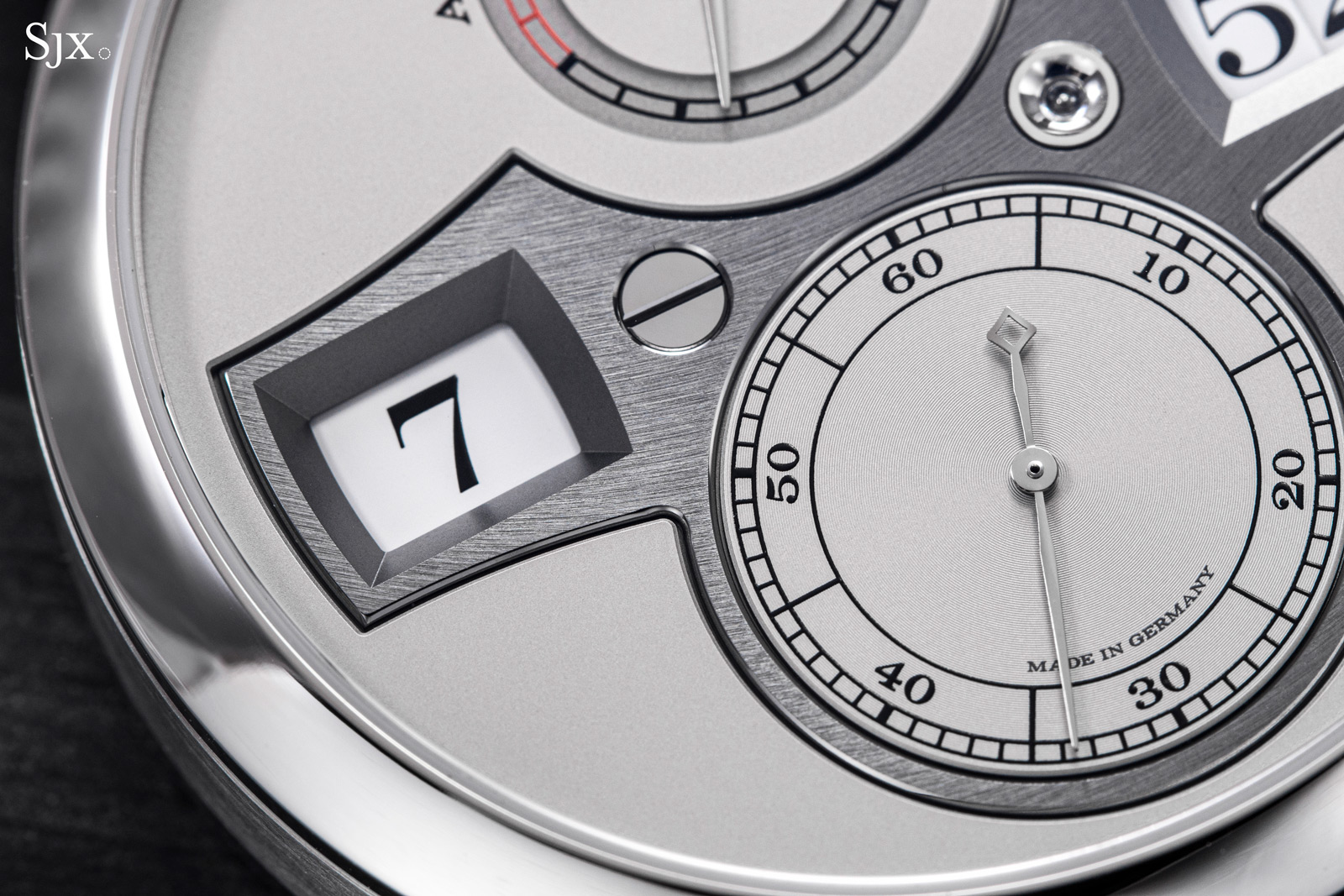
First, it eliminates the tedium of cycling through 60 minutes – up to 11 times at the extreme – when setting the time. While the pusher only advances the hours forwards, it is still more convenient and quicker than setting the time with the crown.
Second, it reinforces the digital nature of the Zeitwerk by creating a tactile interaction with the digital display. Lastly, the pusher also makes the Zeitwerk a travel-friendly watch since the time zone can be altered without interrupting timekeeping.
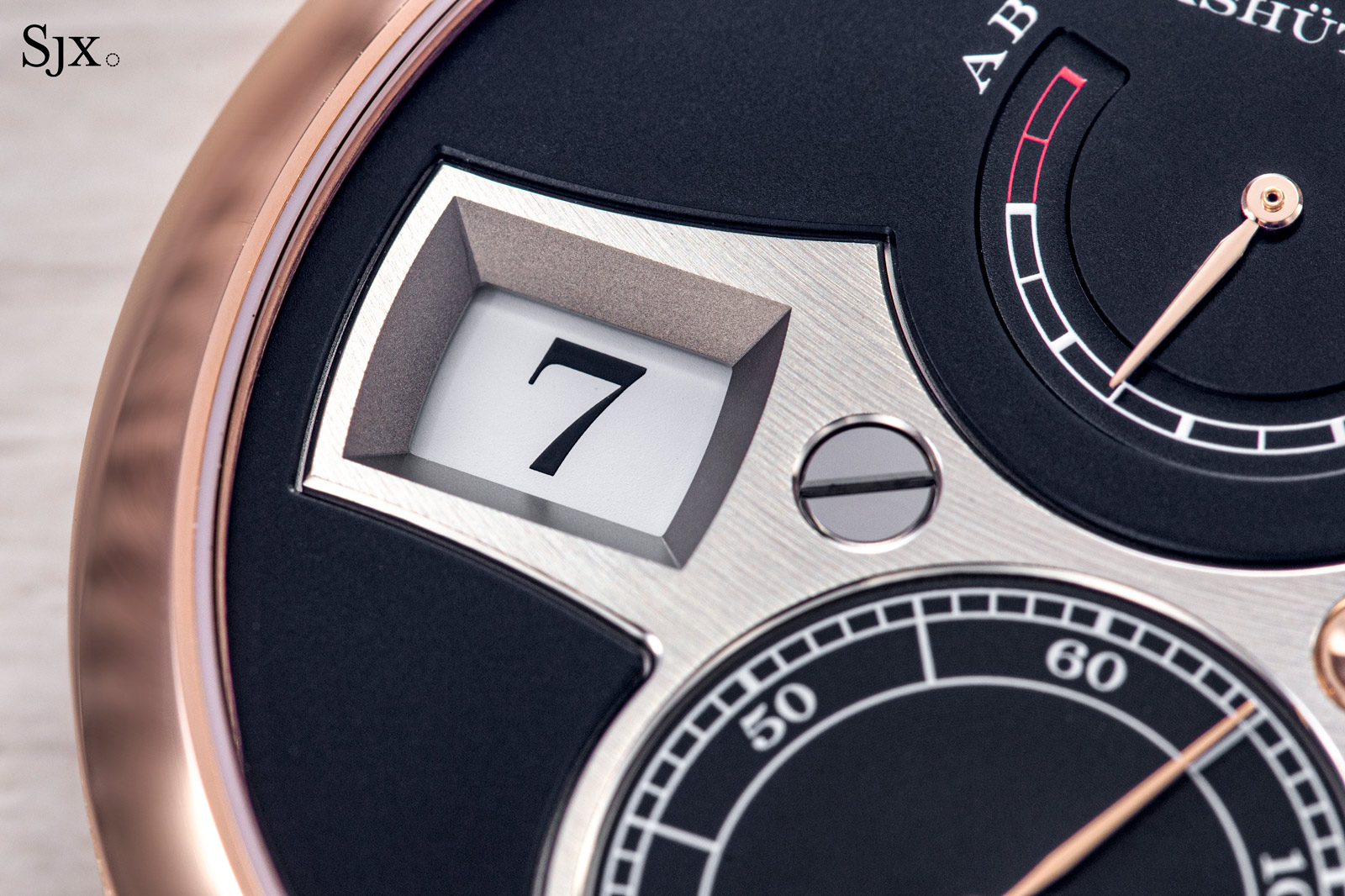
Despite being an ostensibly straightforward function, the hour pusher is constructed in typical Lange fashion – complex and reliable. It incorporates an “all-or-nothing” mechanism that is similar to that found in the slide of a minute repeater. This means that the pusher only operates when fully depressed, but does nothing if only depressed halfway, eliminating risks of accidental activation.
The concept behind the pusher is easy to understand: the button (1) pivots a lever with a spring-loaded pawl (3) at its tip that only passes the cam on the hour wheel when the lever is fully pivoted inwards.
Upon release of the pusher, the lever springs back to its neutral position thanks to a detent spring (2), in the process causing the pawl to advance the hour cam one notch forward. Notably, this configuration means the hour disc only advances when the pusher is released, rather than when it is depressed.
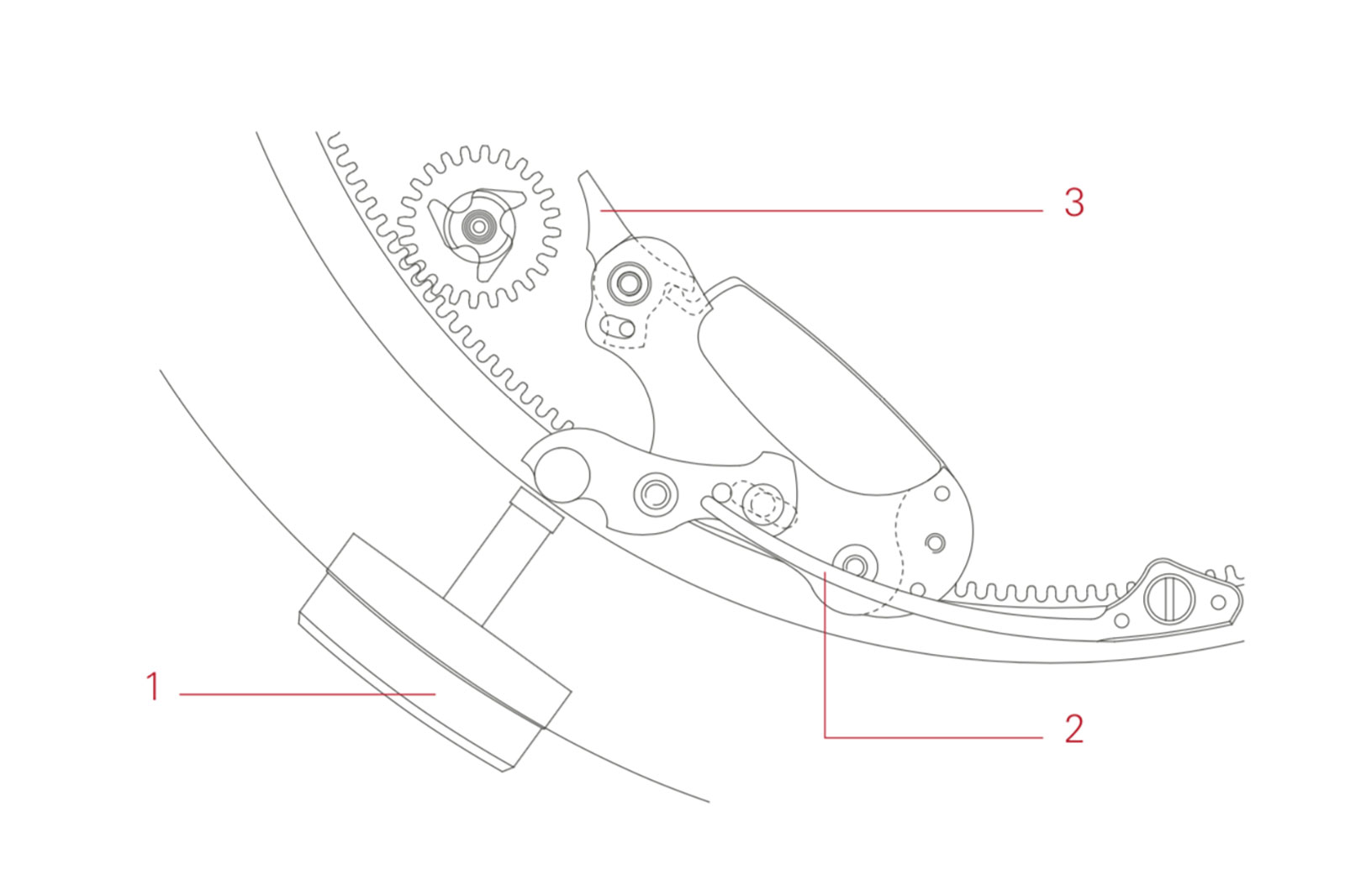
The all-or-nothing quickset set mechanism in the Zeitwerk Date that is identical to the hour mechanism in the new Zeitwerk. Image – Lange
Double capacity
The other notable movement upgrade is the lengthened power reserve that effectively doubles the running time from one day to three. The increase from 36 to 72 hours was achieved by a combination of feature, with the most notable being a new barrel set-up consisting of two stacked barrels arranged in series, effectively lengthening the power reserve without increasing the footprint of the barrel.
Each of the two mainsprings in the new movement are almost identical in length to the single mainspring in the original, but are slightly narrower in width. For comparison, the single mainspring in the original Zeitwerk is about two-thirds the height of the two stacked mainsprings in the new Zeitwerk.
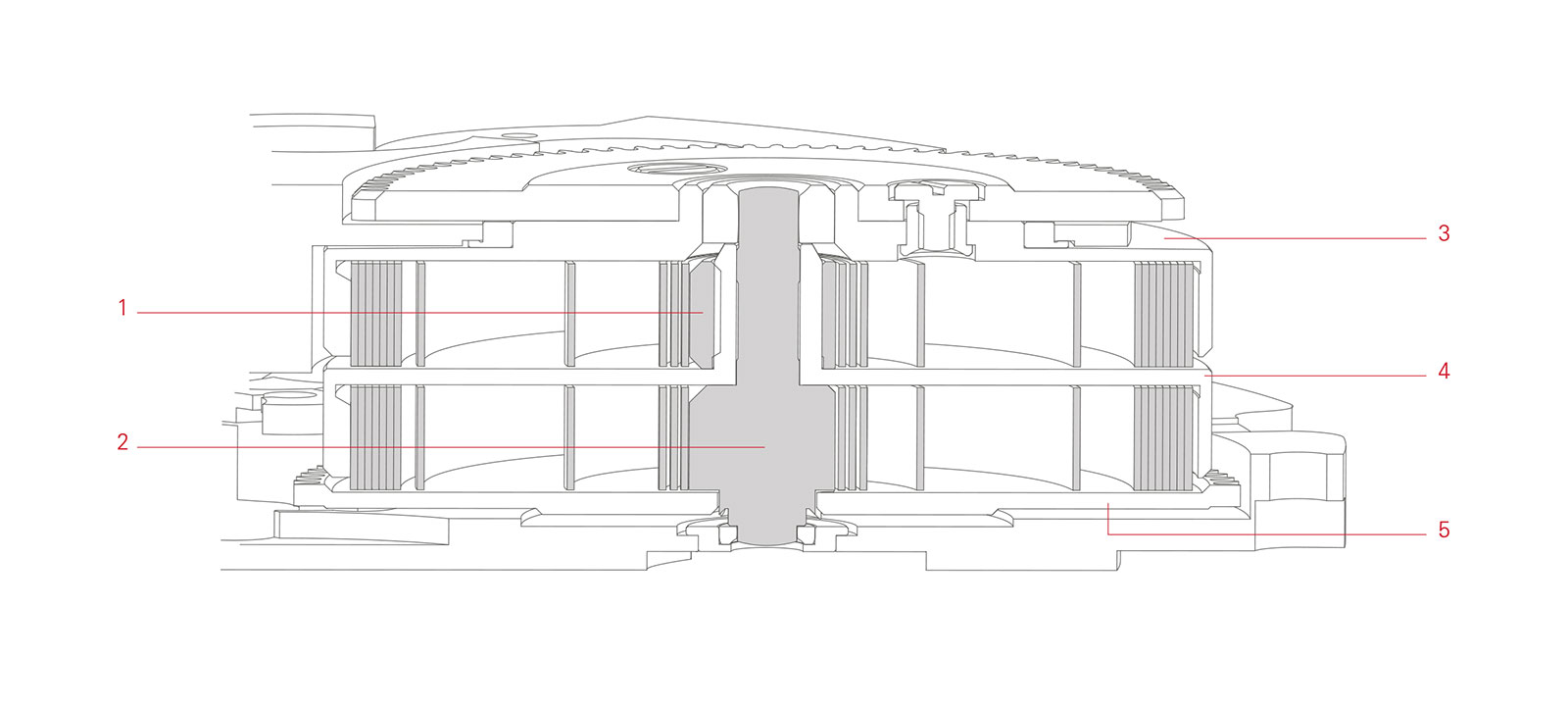
The “floating” construction of the two stacked barrels in the new movement
The new barrel set-up streamlines the movement design as the barrel is now “floating” with the ratchet wheel fully visible on top. In the first-generation movement, the barrel was supported by a jewelled, ring-shaped bridge secured by three screws.
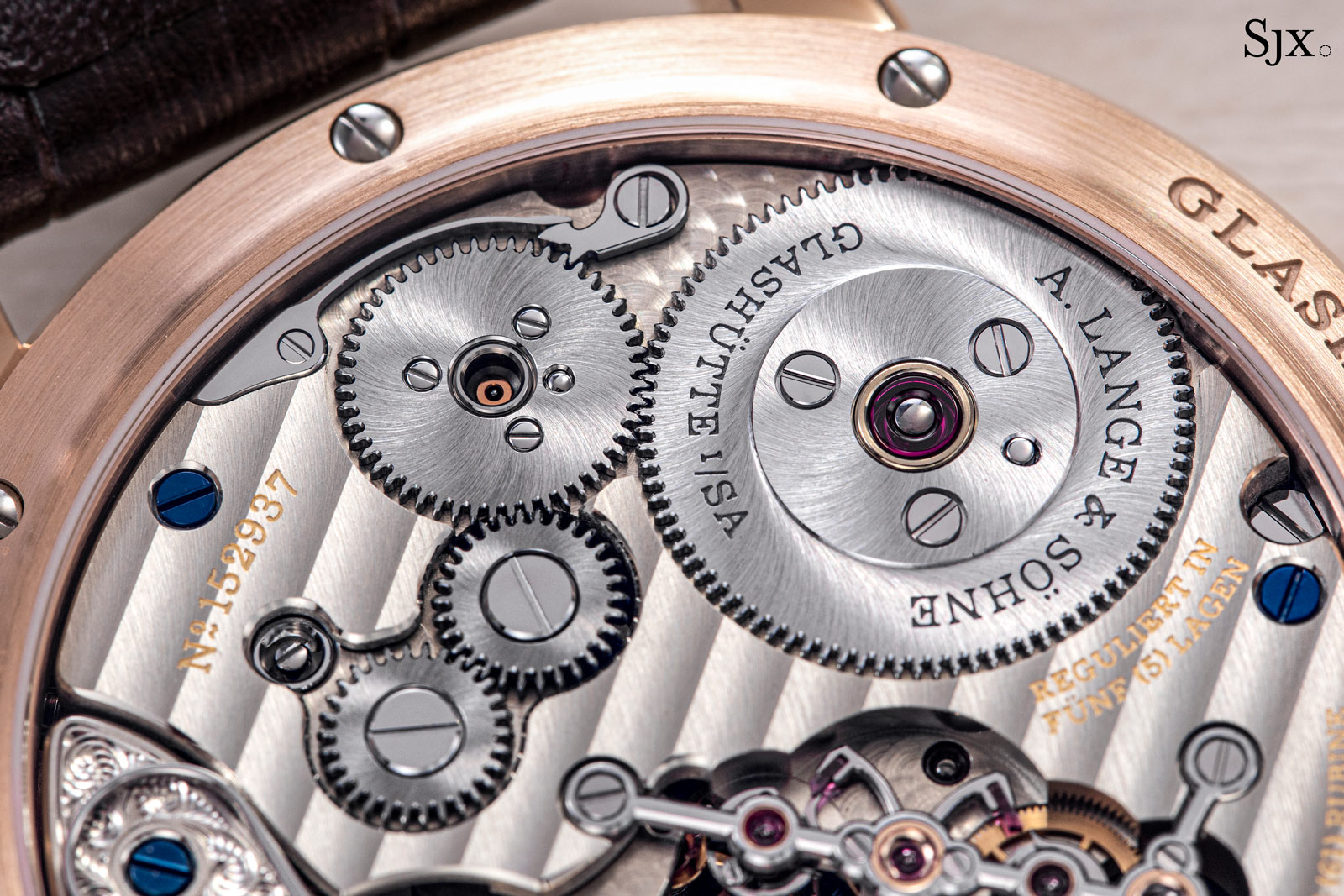
The four wheels that wind the mainspring begin just beside the crown and end with the barrel ratchet wheel
Furthermore, the new barrel does away with the need for the Maltese-cross stopwork that’s one of the key visual elements of the first-generation movement.
Even though the twin, stacked mainsprings are taller, the simplified overall barrel construction means the new Zeitwerk is 0.4 mm thinner than the first-generation model – an impressive achievement considering all of the refinements over its predecessor.
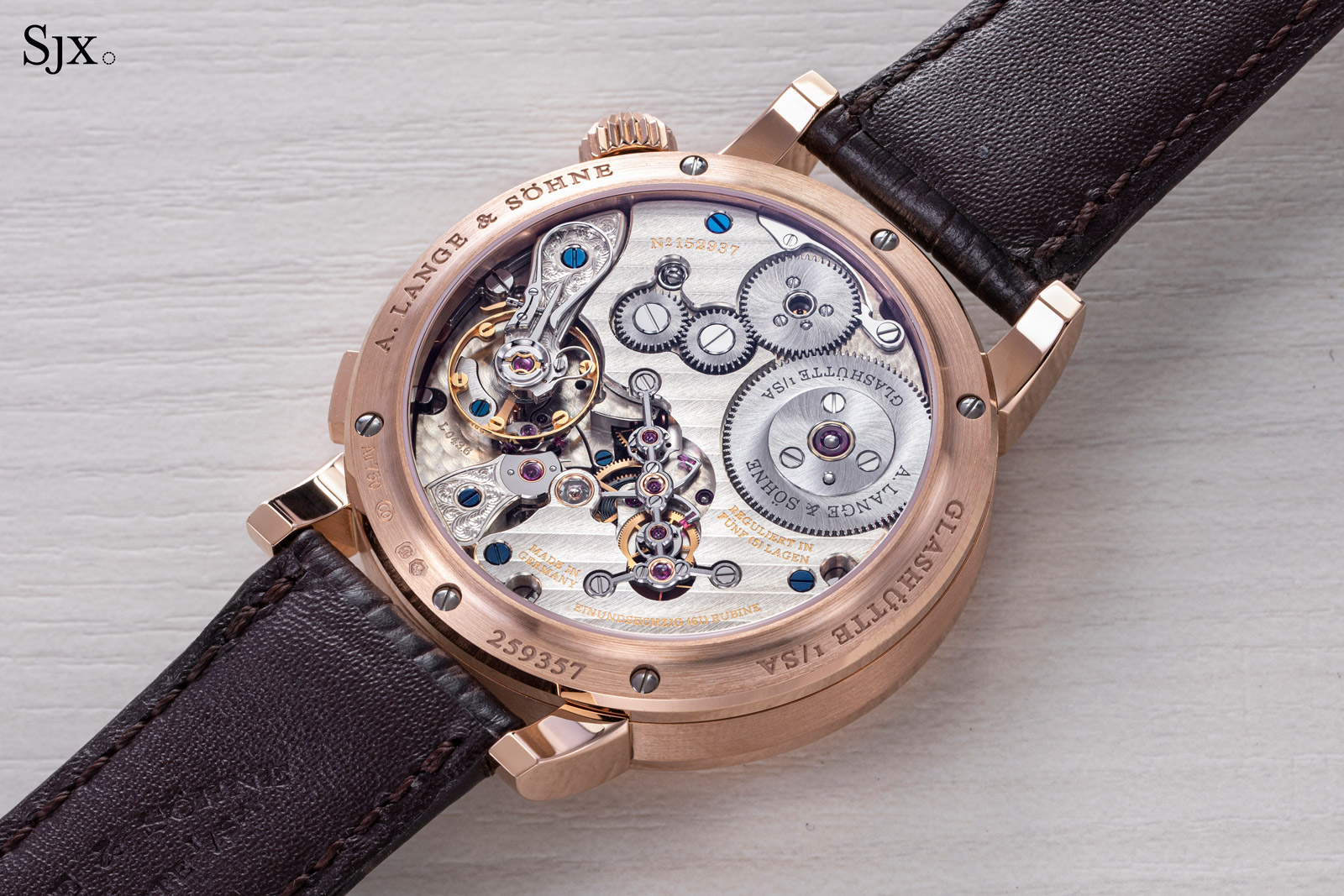
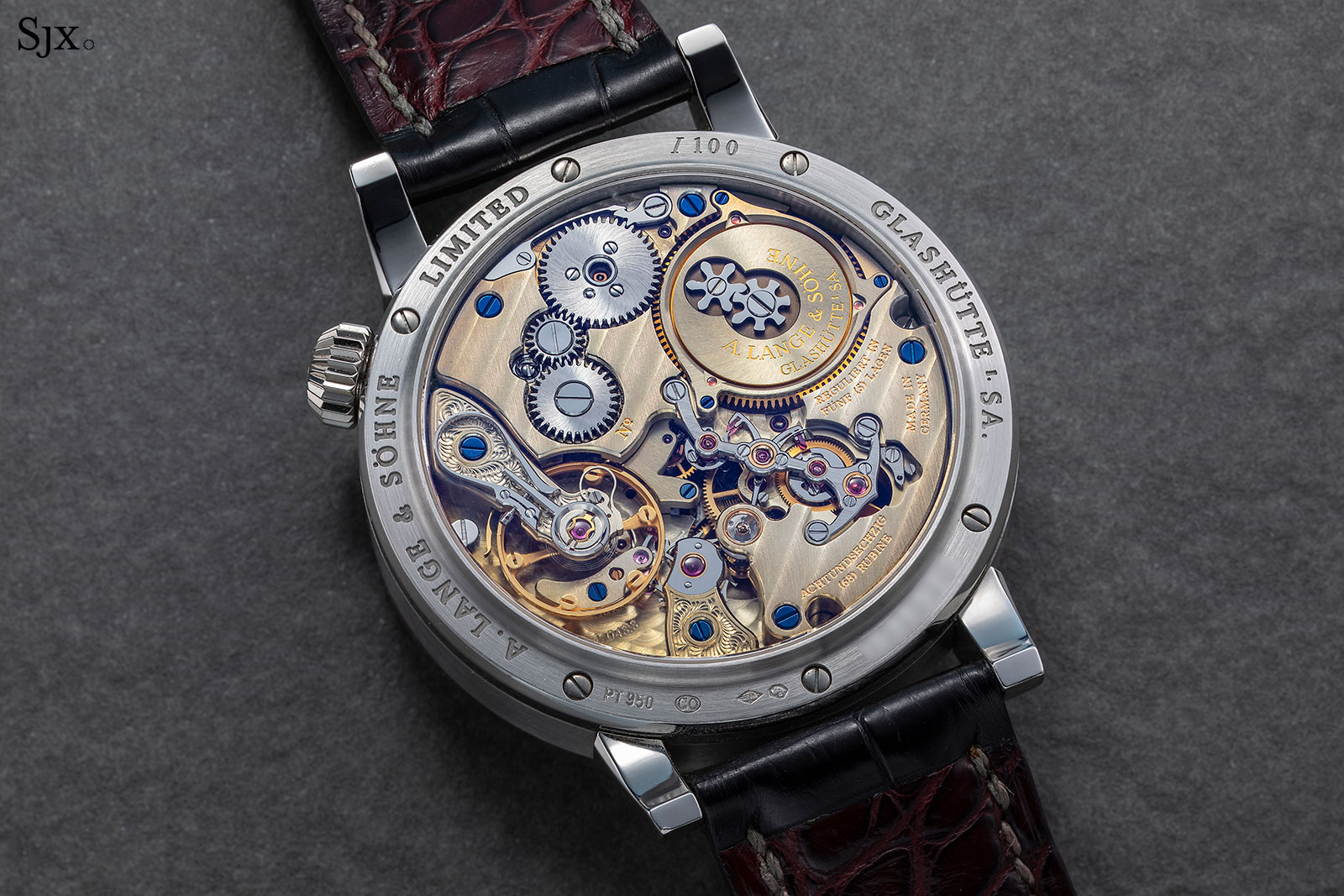
The first-generation movement with its kinked remontoir bridge and ring-shaped barrel bridge
Improved gears and wheels
Besides the mainsprings, the extended power reserve is also due to a more efficient gear train. Specifically, the remontoir spring is now thinner while the balance wheel is lighter – contributing to a reduction in the energy needed to power the movement.
Being lighter, the balance wheel requires less energy to oscillate. However, it remains a free-sprung balance that runs at a leisurely 18,000 beats per hour, or 2.5 Hz.
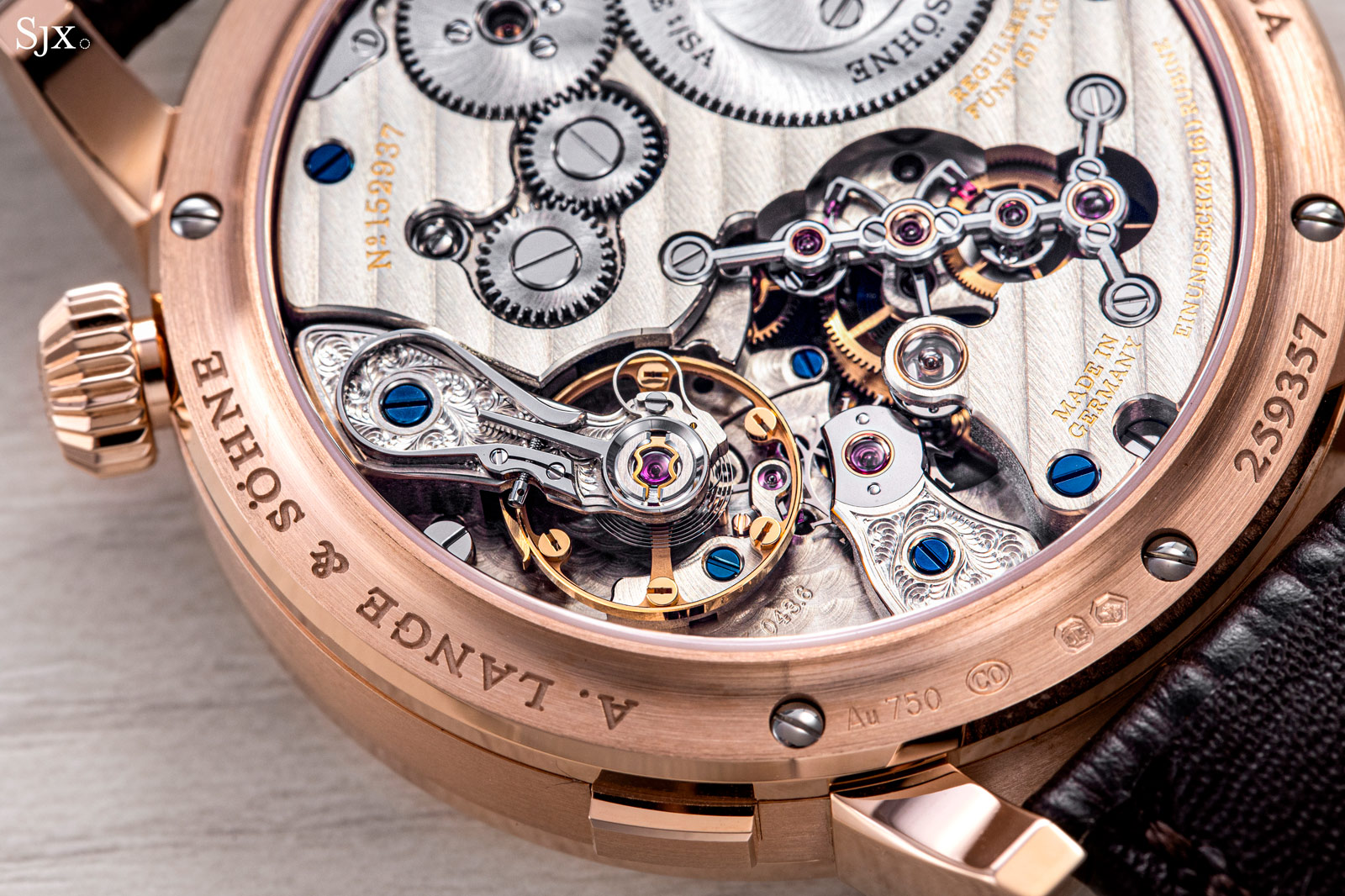
That, combined with the optimised gear train, leads to a substantial reduction in energy consumption by the remontoir. Robert Hoffmann, head watchmaker of the Zeitwerk department, explains that the energy used to rewind the remontoir spring only leads to a five-degree drop in balance wheel amplitude, compared to 35 degrees for the original movement.
Though it has been optimised, the redesigned remontoir operates on the same principles as that of the first-generation movement. The central component of the remontoir is the Y-shaped pallet lever under the centre of the remontoir bridge, which slowly oscillates back and forth in one-minute cycles, precisely releasing the remontoir mechanism once a minute.
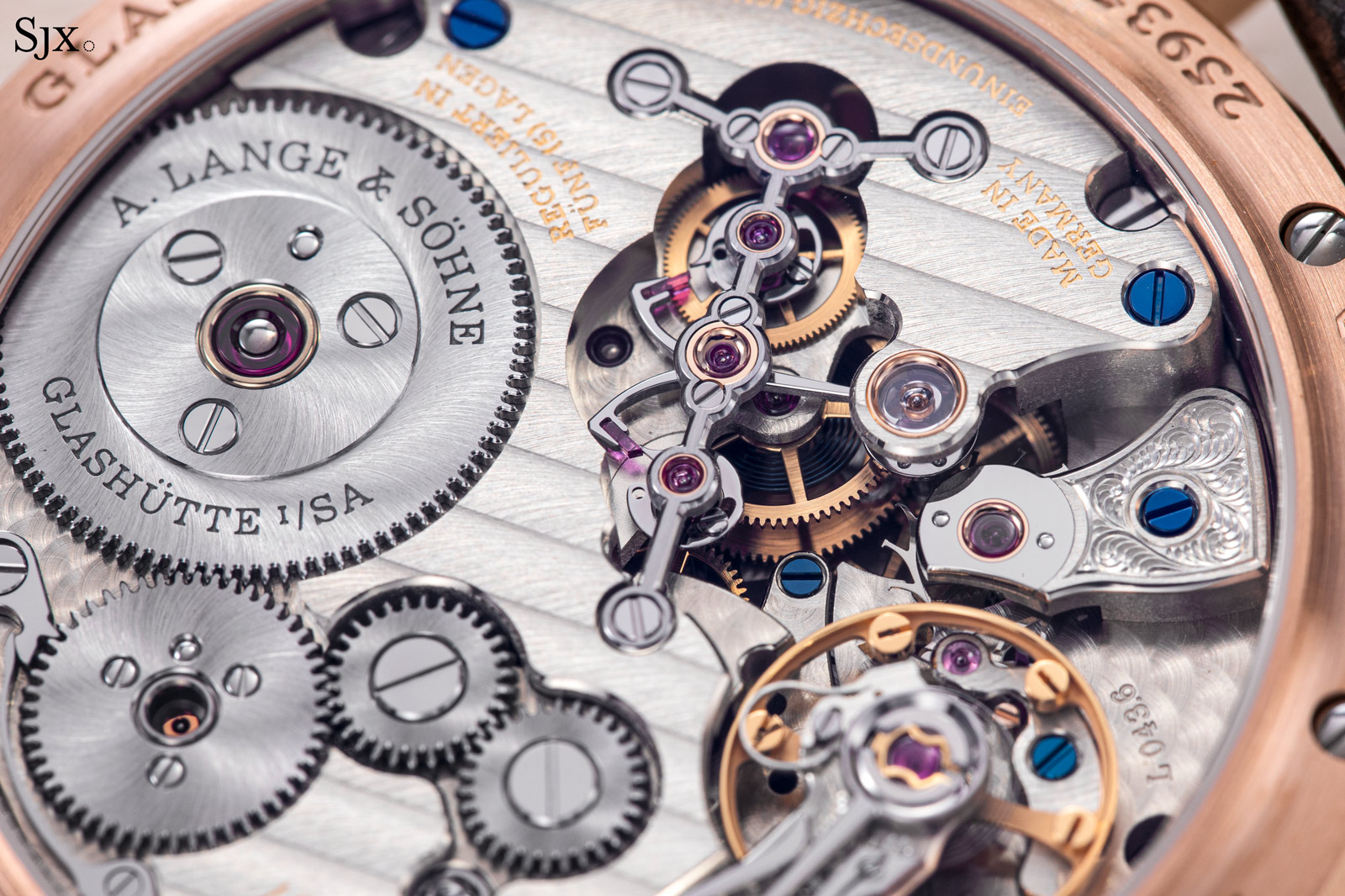
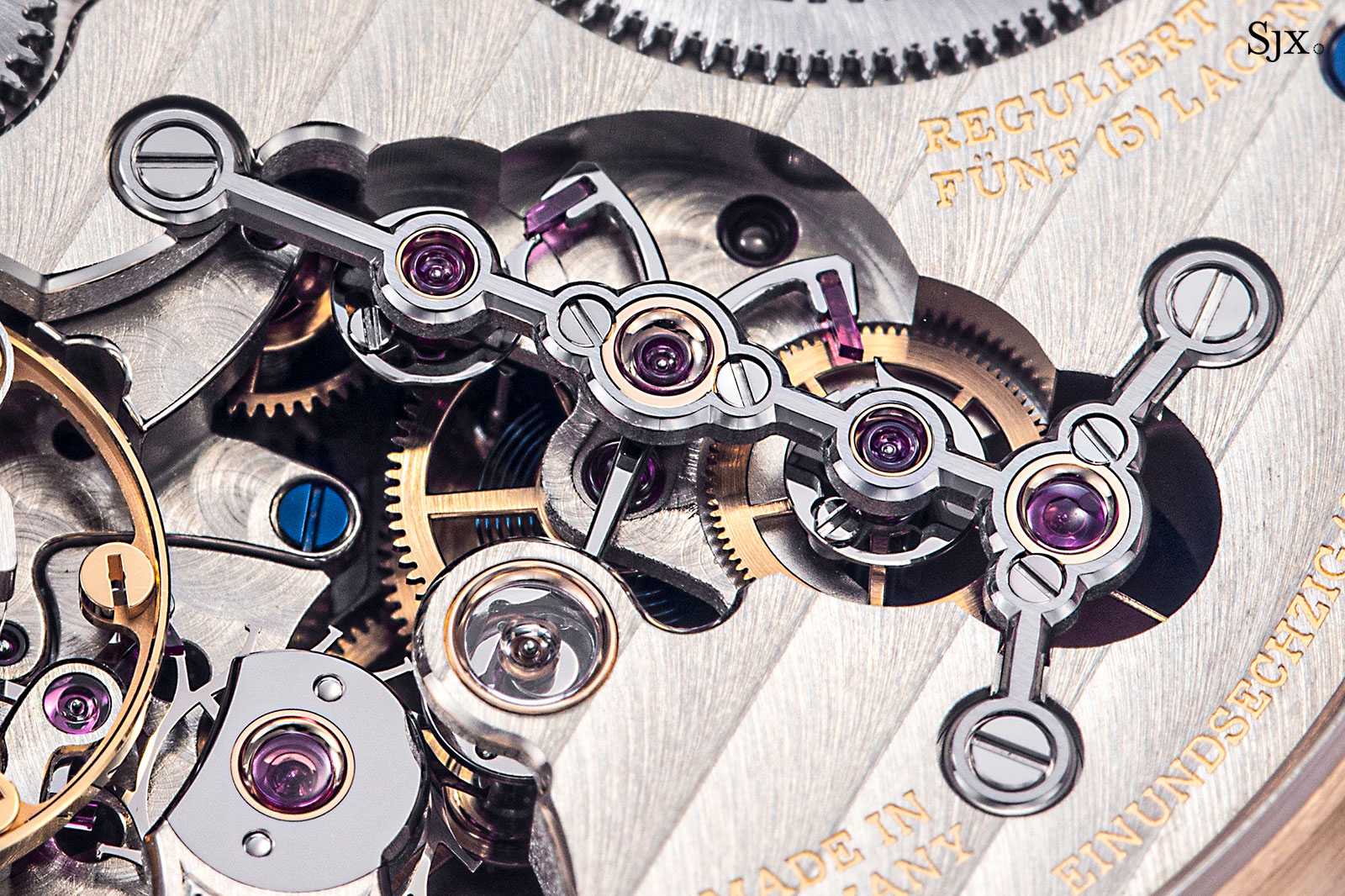
The remontoir bridge with its Y-shaped pallet lever
This burst of energy as its releases is the force that drives the heavy hour and minute discs of the digital display, a feat accomplished without disturbing power flow to the balance wheel since the energy needs of the time display have been isolated by the remontoir.
In terms of aesthetics, the remontoir is now very different from its predecessor. It’s been streamlined to sport a linear steel bridge, as opposed to the (in)famous kinked-anchor bridge of the original. The new bridge is clearly neater and cleaner, though it perhaps lacks the idiosyncratic charm of the original, which had beauty in its distorted form.
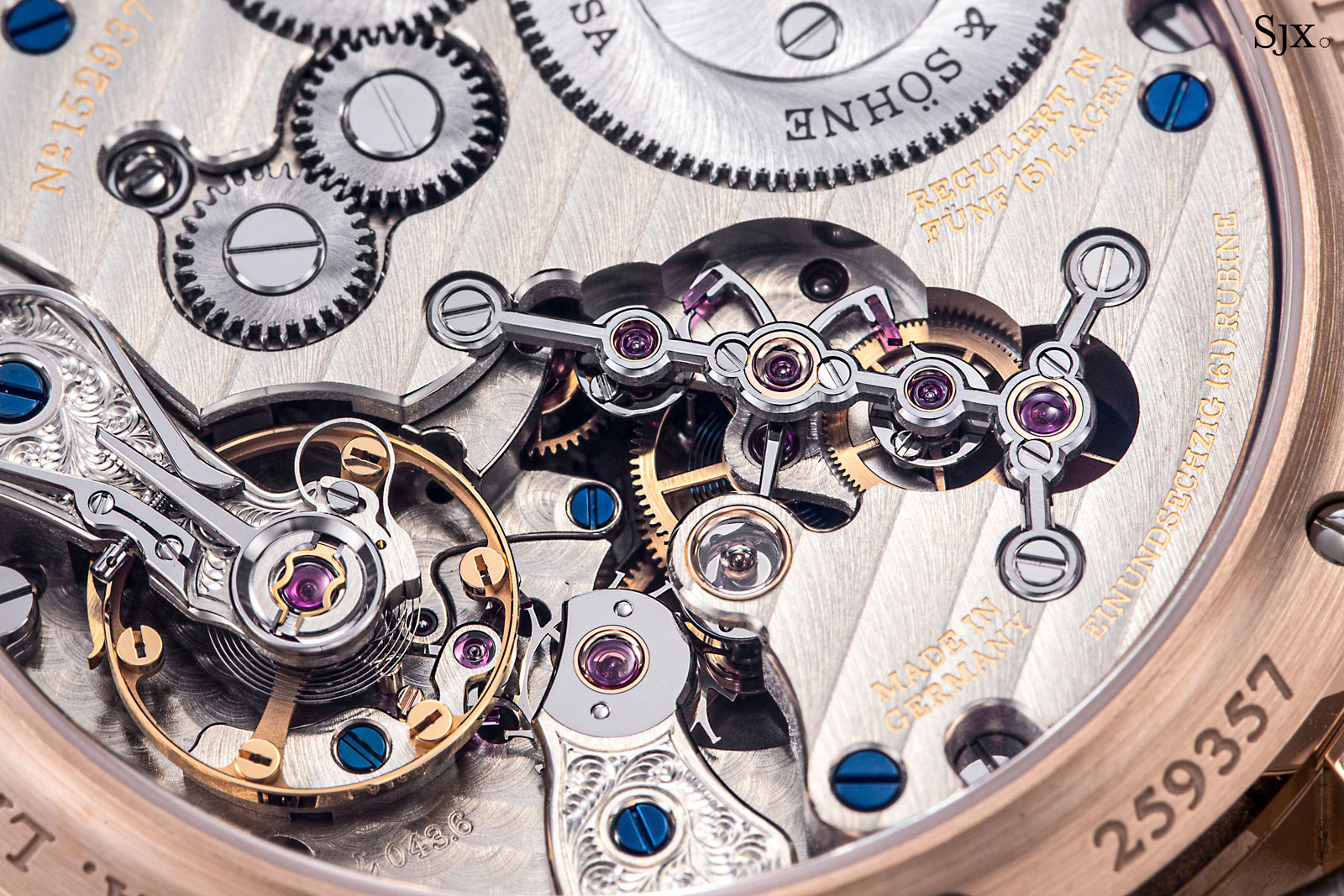
In contrast, the regulating organ is classic Lange. Both the balance and escape wheel cocks are hand-engraved with a floral motif, as they were in the original movement. However, the balance cock features Lange’s latest form of stud holder.

The engraved escape wheel cock is special. Most Lange movements only sport an engraved balance cock. The engraved escape wheel cock is a flourish typically found only in limited editions or top-of-the-line complications like tourbillons.
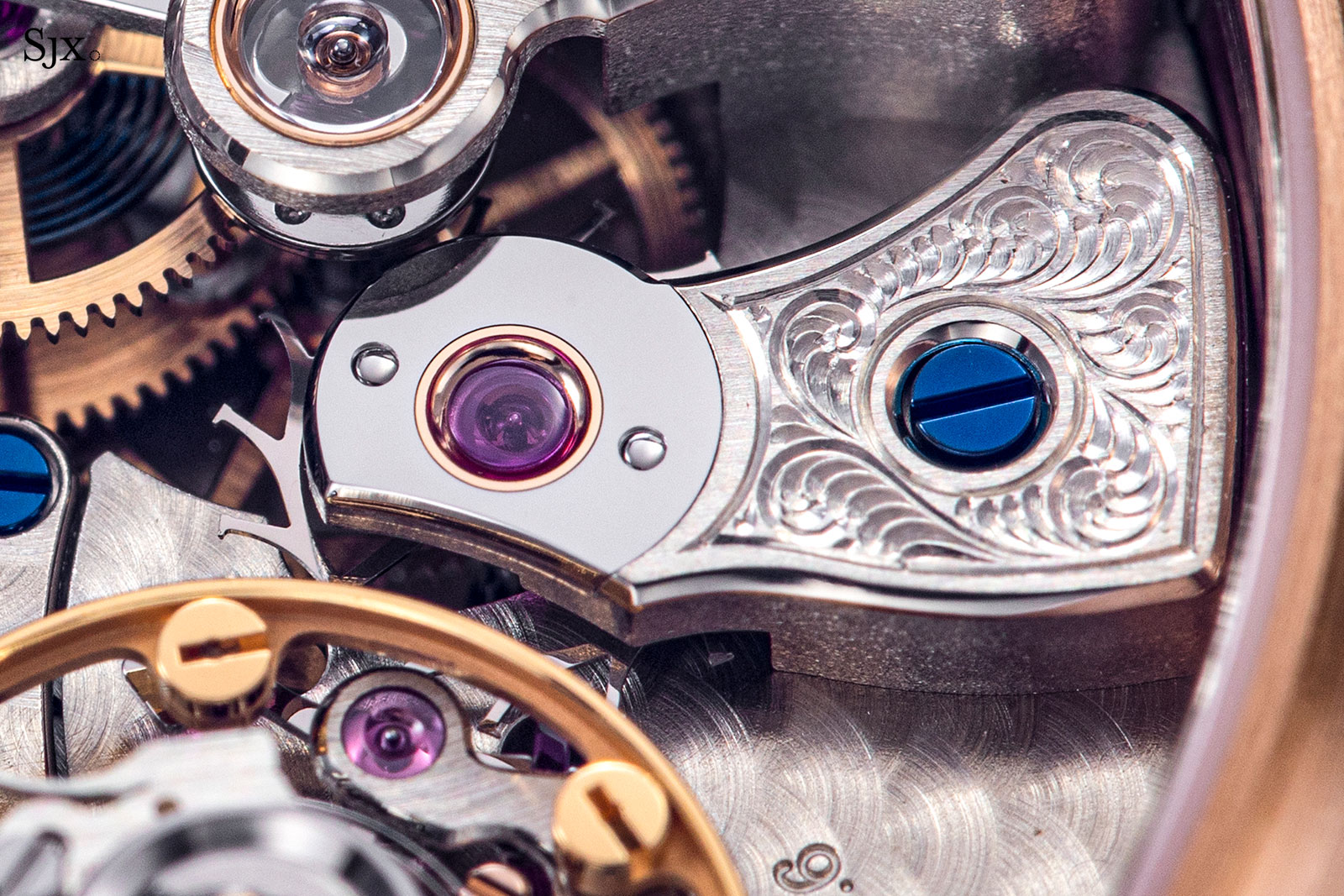
The escape wheel cock is elaborately executed with not only engraving but also a black-polished steel cap for the jewel that sits in a gold chaton
Updated decor
The movement finishing in the new Zeitwerk is as expected from Lange, which is to say top-shelf and perhaps the best amongst large manufacturers. All of the hallmark decorative elements are present, like the German silver bridges with prominent anglage along most edges and the polished gold chatons for the larger jewels.
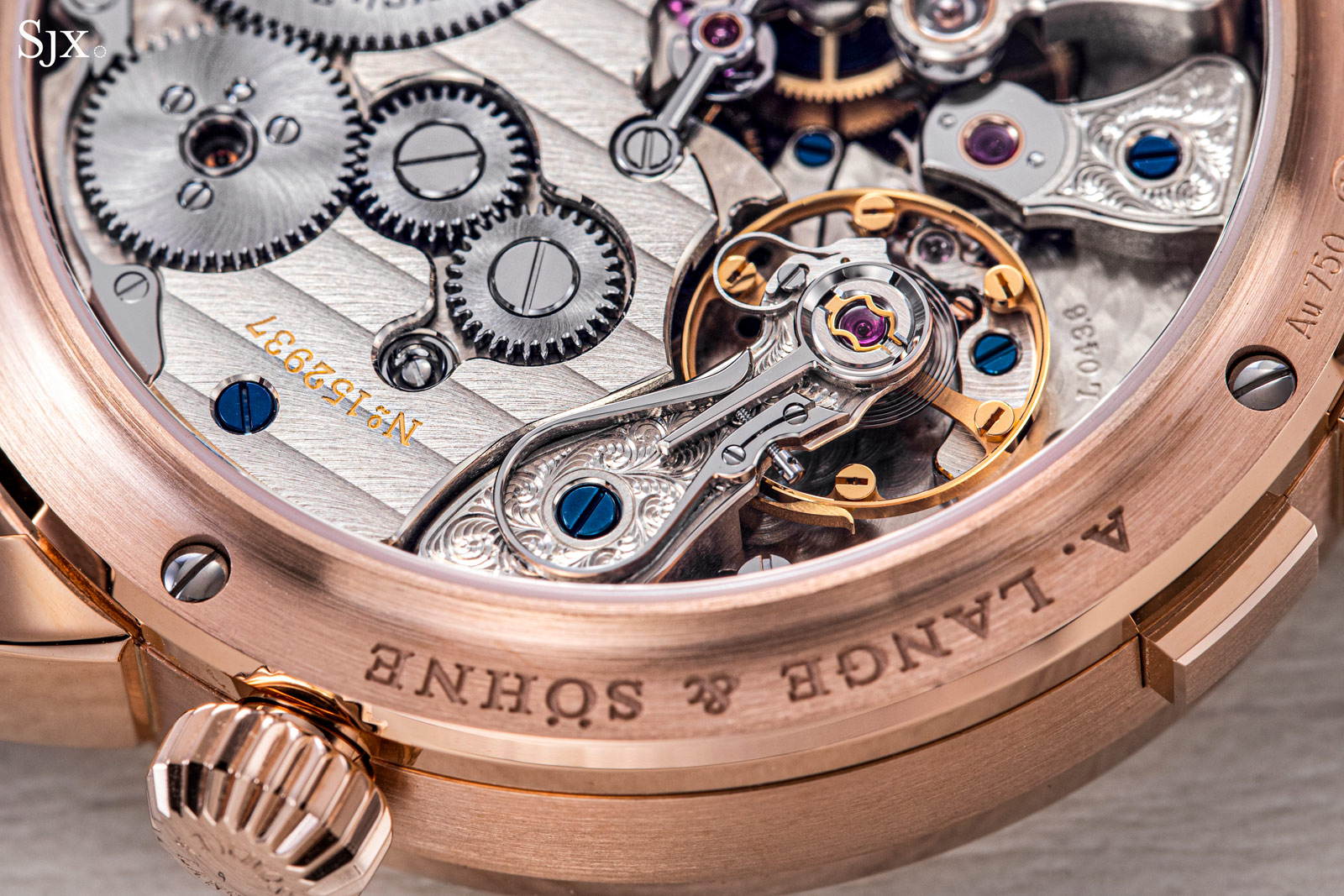
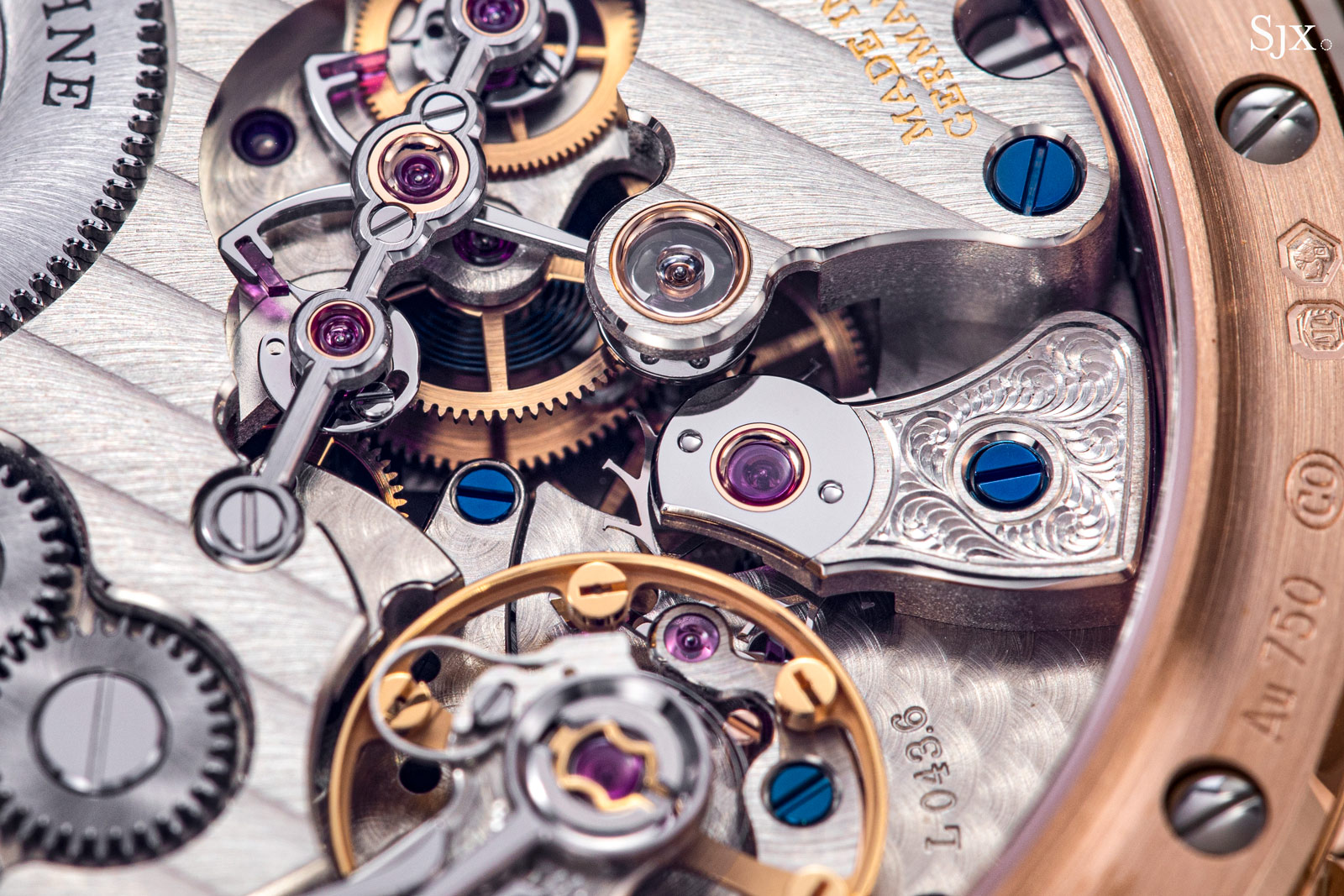
Some elements are unique to the Zeitwerk movement due to its unusual features. One being the snaking steel gear train for winding the barrel made up of four wheels. All four have polished teeth – with mirrored edges on the top edges and recesses – an exceptionally fine detail that is not only executed well but gives the movement an almost-artisanal feel.

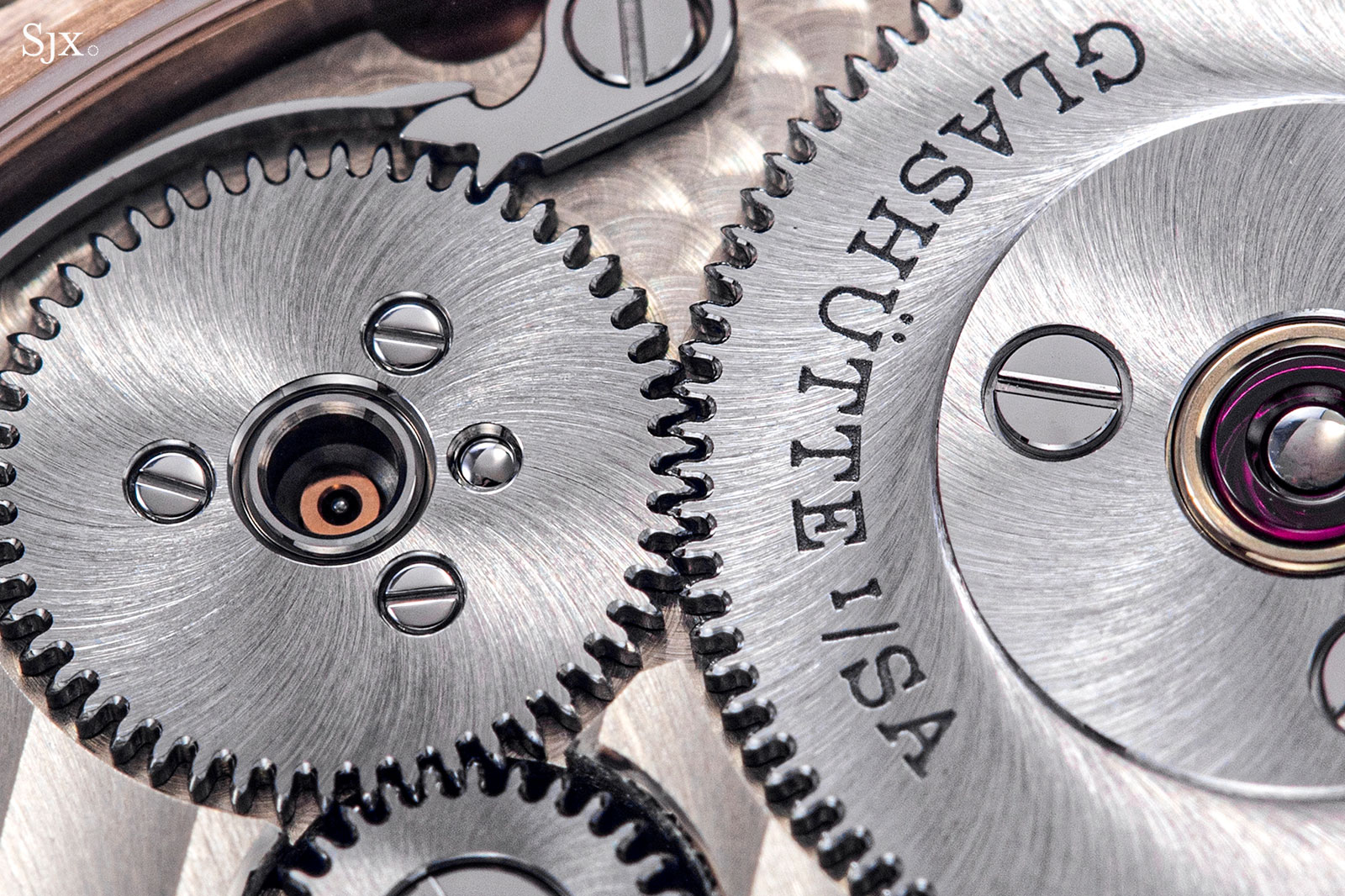
Since the ratchet wheel is now exposed in the new movement, the polished teeth are especially easy to admire in their full glory since the barrel ratchet is the largest visible wheel
Another detail unique to the Zeitwerk movement is of course the linear remontoir bridge. Rendered in black-polished steel, the bridge is clearly laboriously finished – it has 32 inward angles along its bevelled edges.
Like all similar components in Lange movements, the bridge is finished by hand with a cone-shaped, rotating abrasive disc that can reach the inward angles. One consequence of this technique is the ever-so-slight, almost-invisible irregularity along the straight edges of the bridge, something apparent only under high magnification.
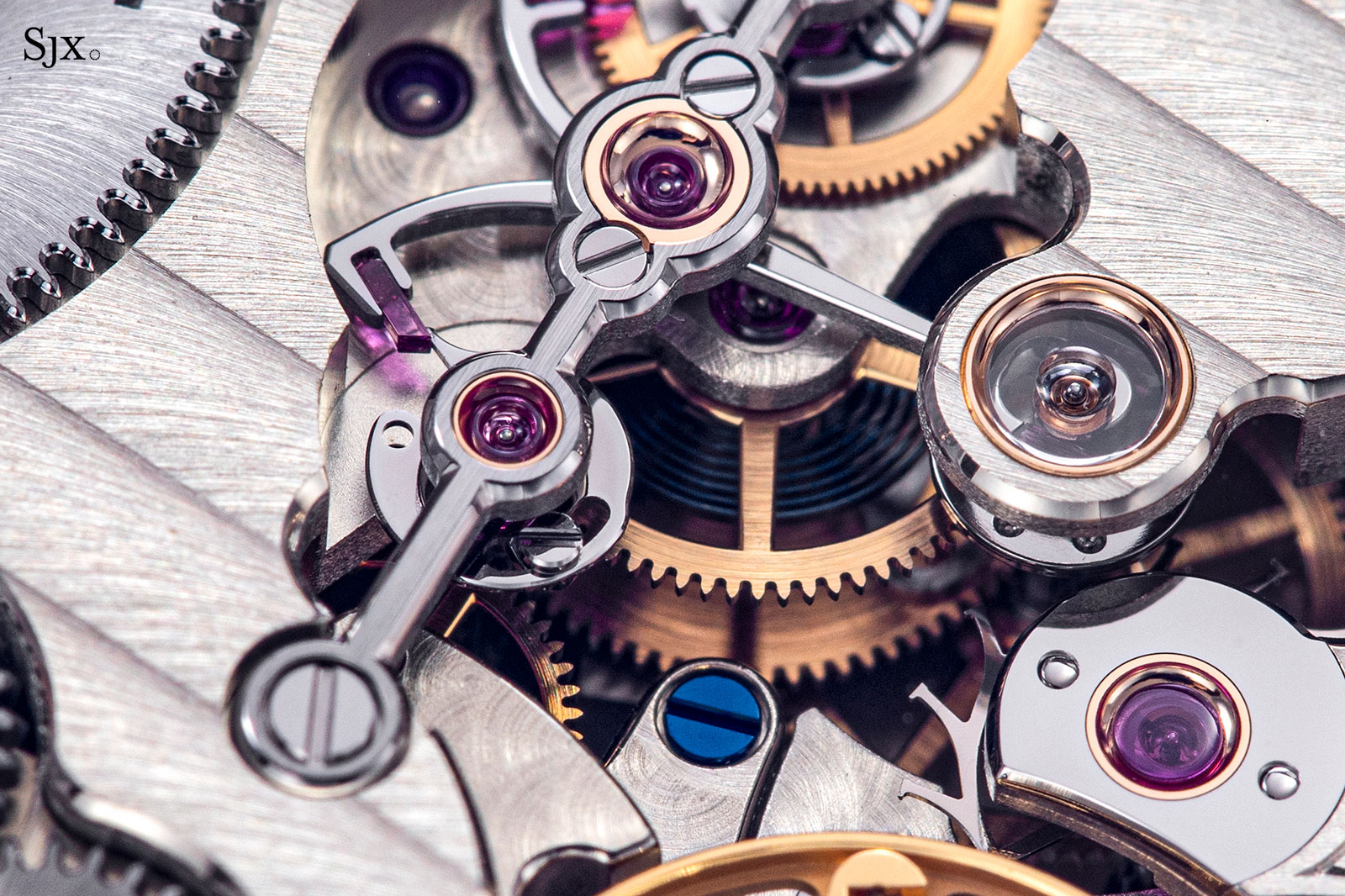
Even though the new movement is exemplary in nearly all respects, its redesigned mechanics, while functionally superior, arguably result in simplified finishing in one respect.
Due to the streamlined construction of the remontoir and barrel, the area of the three-quarter plate around the remontoir is cleanly machined but plain, with some of the circular cutouts for the remontoir having no bevelling. This area was concealed in the first-generation movement by the anchor-shaped remontoir bridge and barrel bridge.
There is presumably a technical reason for this ostensible omission, either due to production processes or the nature of the components, since that would only be logical and Lange movements are always logical. At the same time, it doesn’t detract from the overall appeal of the calibre.
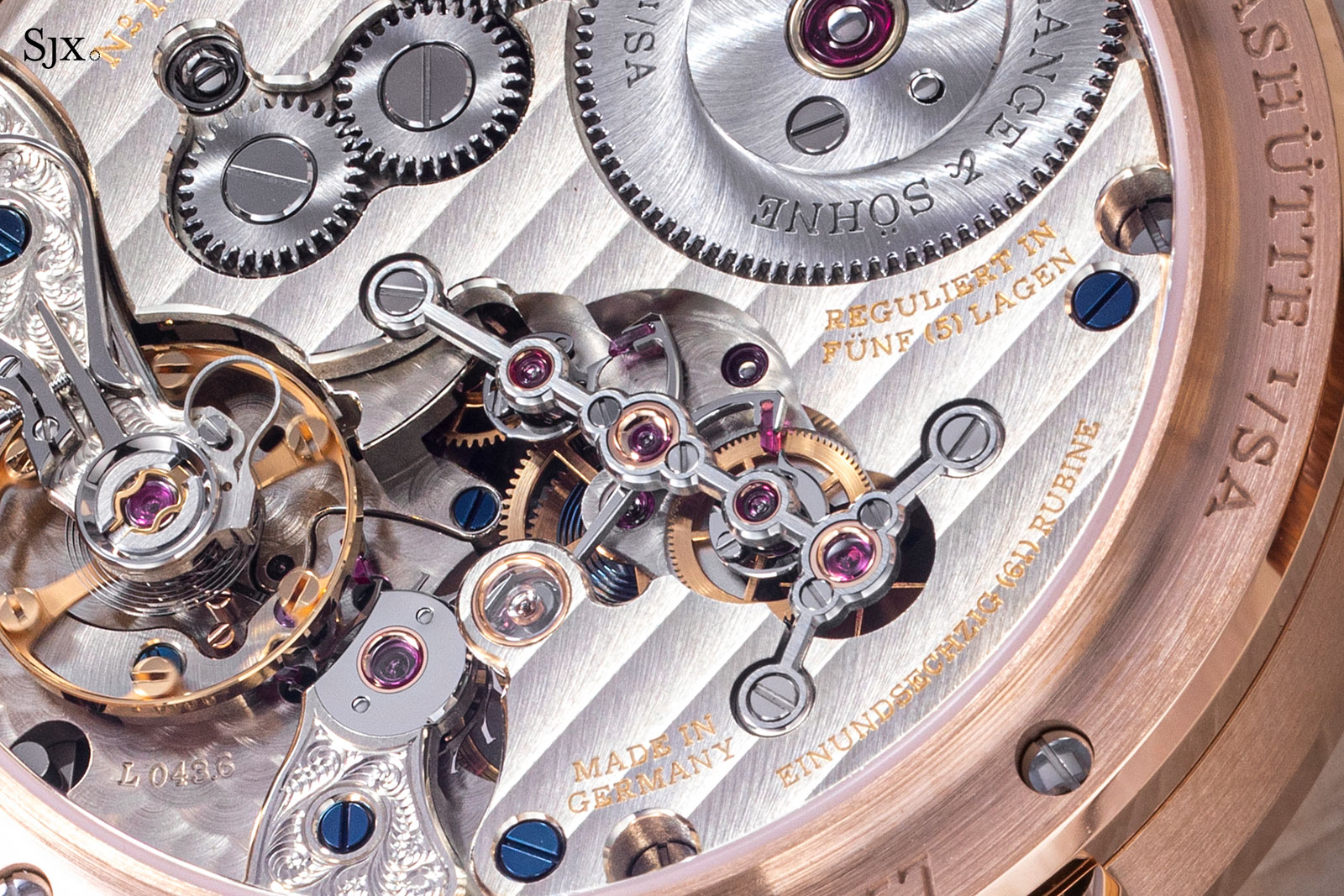
Conclusion
The new Zeitwerk is essentially the same as its predecessor in terms of look and feel, but with improved technical features and practicality. That means it’s a tangibly superior watch to original.
Already the original was a magnificent achievement – with a magnificent complexity belied by the simple display – which means the new Zeitwerk is a bettered magnificent achievement.
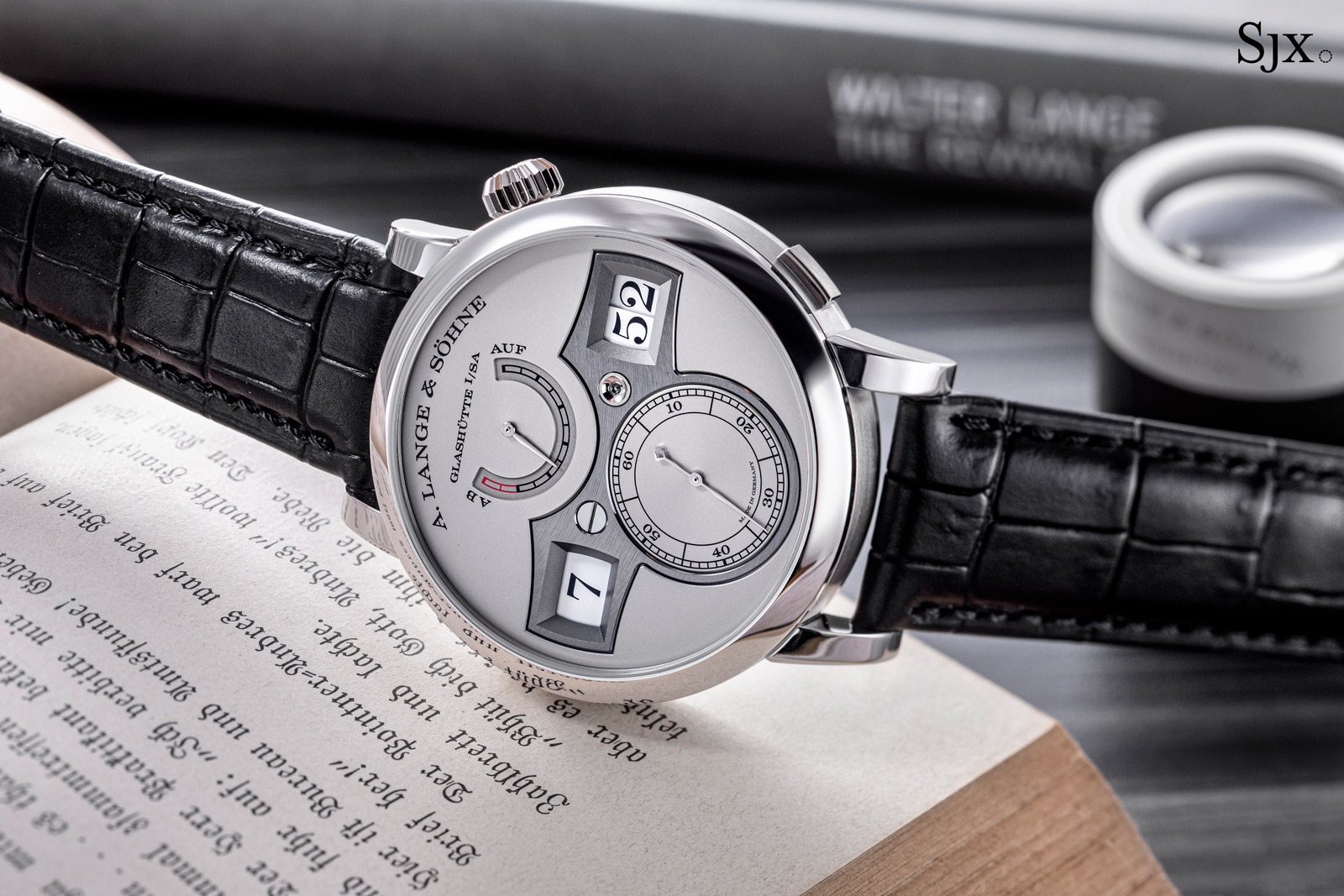
Key facts and price
A. Lange & Söhne Zeitwerk
Ref. 142.025 (Platinum with silver dial)
Ref. 142.031 (Pink gold with black dial)
Diameter: 41.9 mm
Height: 12.2 mm
Material: 18k pink gold or 950 platinum
Crystal: Sapphire
Water resistance: 30 m
Movement: L043.6
Functions: Hours, minutes, seconds, power reserve indicator, and quickset hour corrector
Frequency: 18,000 beats per hour (2.5 Hz)
Winding: Hand wind
Power reserve: 72 hours
Strap: Crocodile with pin buckle
Limited edition: No
Availability: Now at Lange boutiques and authorised retailers
Price: On request
For more, visit Alange-soehne.com.

